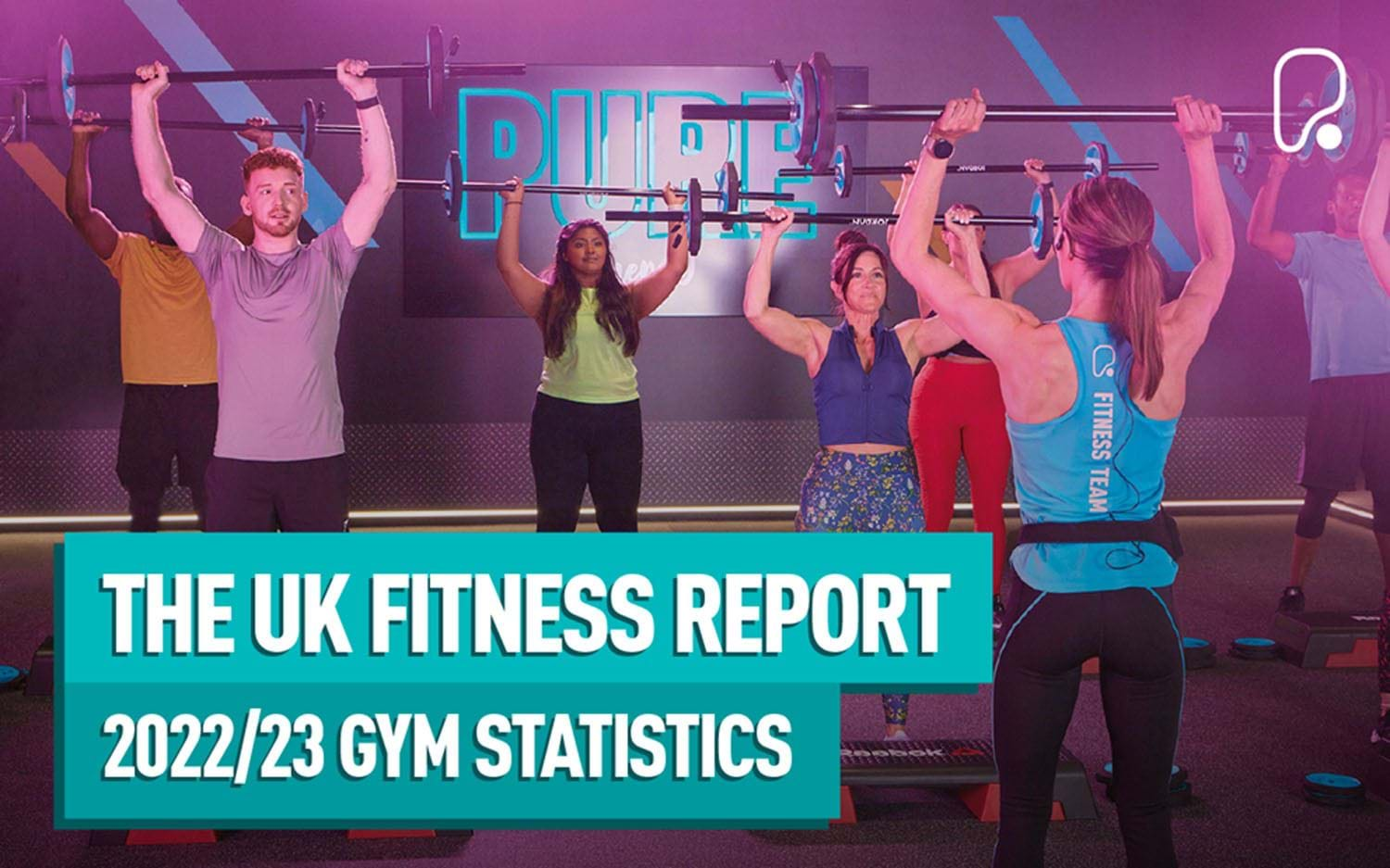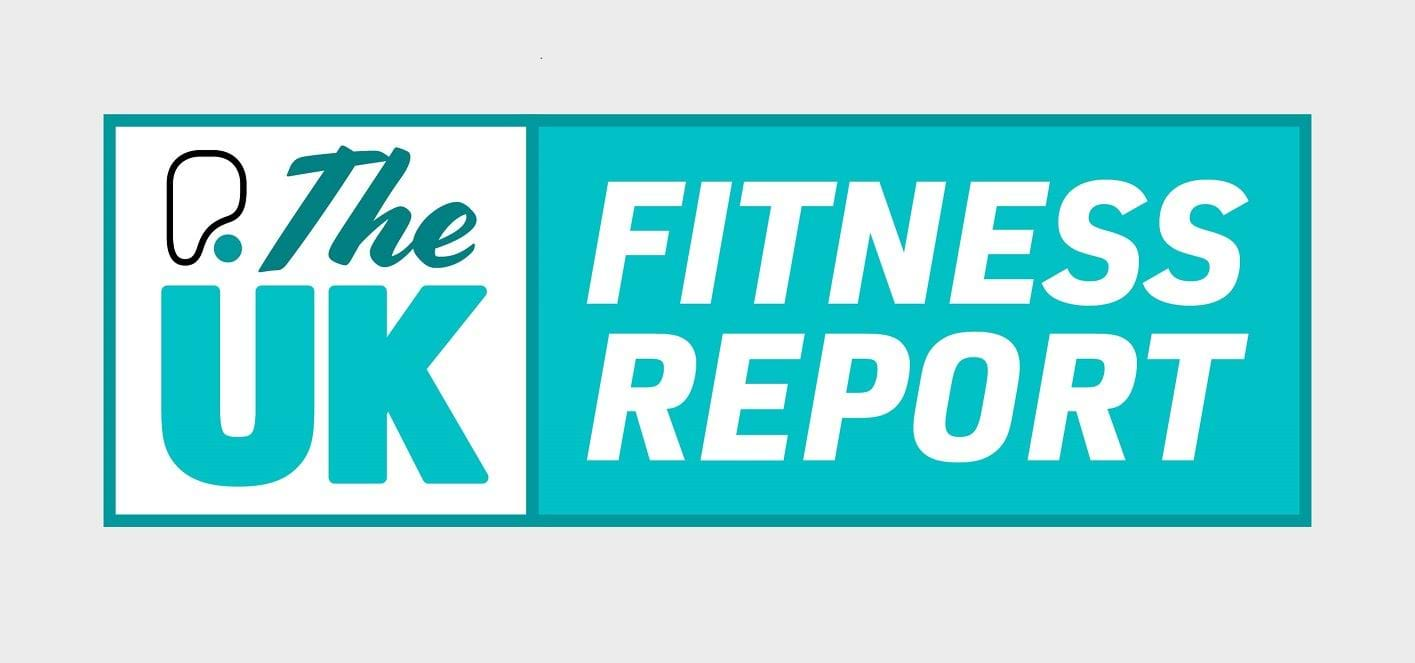THE UK FITNESS REPORT – 2024/25 GYM STATISTICS

Welcome to the annual PureGym UK Fitness Report! In its third year, we're continuing to build on what we started back in 2022 and are taking another comprehensive look into how the nation feels about health and fitness, the gym and our collective goals for 2025.
With three years of research in our back pocket, we'll also be tracking how these attitudes and behaviours are changing over time. But where has our research come from? We're aware that as a low-cost gym provider, our own data may not be representative of the entire nation, especially within areas where we don't currently have gyms, so alongside our own internal customer data, we've utilised data from YouGov, Google and a nationally representative survey. This combination of multiple data sources enables us to see the full picture of health and fitness in the UK and beyond.
We've also worked with experts to help us decipher what the data means and provide useful advice so that anyone reading this report can improve their health and fitness in 2025.
Ready to learn about how our relationship with technology is developing, all the way to the latest fitness trends? Let's dive in!
What the report covers:
Summary
Back in 2022 we created the first UK Fitness Report to provide a snapshot of health and fitness within the UK and to develop a deeper understanding of the specific areas that need addressing, help us to become a healthier nation overall.
Three years on from this first edition, we're noticing positive changes. Better health has long been an aspiration of the population, with 76% of people stating that they 'aspire to be healthy' as we reach the close of 2024. The good news is that more people are now working towards reaching these aspirations. 48% of us are taking part in regular exercise, which is a 3% increase on the number of people exercising just one year ago. While this might seem small, it accounts for approximately two million more people who will get moving in the space of a single year.
This encouraging stat is reflected in multiple findings throughout the latest edition of the report, with data revealing the nation is feeling healthier and getting more active on the whole. Struggles such as gymtimidation have also become less of an issue in the space of a year, with 8% of people reporting they feel intimidated by the gym, versus the 21% that did at the tail end of 2023. And despite ongoing cost of living concerns, we have even found that 1 in 4 (24%) have increased their spending on purchases related to their health.
This positive move towards more priority on exercise and good health is being led by younger generations: a large portion of 18-to-24-year-olds are exercising regularly, with a huge 89% stating that they do some form of strengthening exercise, every week.
However, as with the previous two editions of the UK Fitness Report, our new findings do also highlight that there is still significant room for improvement in some areas and demographics. 1 in 3 feel their mental and cardiovascular health needs improving, and just 1 in 10 people meet the key guidelines for weekly activity laid out by the UK government. In addition, a huge 68% of the population struggle with fatigue.
These may be related, as our data also helps to uncover how exercise is proven to benefit mental and physical health, as well as combat feelings of fatigue and poor sleep. Getting more people moving may be key to breaking the cycle, and it's clear that the onus is on us all to help more people in the UK to find a form of fitness that suits their lives and to continue to chip away at the more concerning stats found within this report.
Thankfully, we've got our personal trainers on hand, as well as expert voices from Mental Health UK and the British Heart Foundation to break down the data and discuss ways we can make that happen.
Covering everything from diet and nutrition to our relationship with health technology, and of course, the fitness trends set to take 2025 by storm, read on for all the latest insights.
Or to read our previous reports, visit:
HOW WE FEEL ABOUT OUR HEALTH IN 2024/25
Key Findings:
76% of people say they 'aspire' to be fit and healthy
65% of people feel they don't look after their health as much as they should (1% improvement from last year)
22% of the population don't consider themselves to be healthy at all (1% improvement from last year)
27% of 45-to-54-year-olds don't consider themselves to be healthy, more than any other age group
Women are more likely to consider themselves as unhealthy (24%) than men (20%)
34% of people want to improve their mental health
34% of people want to improve their cardiovascular fitness, followed by 33% that want to get stronger
As the previous two years of the UK Fitness Report have also shown, being fit and healthy is a major aspiration for the nation, with the vast majority of people (76%) stating that they aspire to be fit and healthy. But are we achieving these aspirations?
It seems there's still a large disparity between our aspirations and how we actually feel, with 65% of people feeling that they don't look after their health as much as they should. This is, however, a slight improvement on the 66% that felt they didn't look after their health enough at the end of 2023.
Last year's stats also revealed that 23% of people didn't consider themselves to be healthy at all, but this year that number has also dropped down a percent, to 22% of people, highlighting that we do seem to be slowly edging towards being a healthier nation, year-on-year.
That does still leave 1 in 5 people that don't consider themselves to be healthy, from either a physical, mental, emotional or social point-of-view. A worrying stat, and one that becomes even more concerning for 45-to-54-year-olds, with the number of people within this age group that don't class themselves as healthy at all increasing to 27%. This is higher than any other age group and followed closely by the 25% of 35-to-44-year-olds that don't class themselves as healthy. As we get older, our lifestyles can naturally become less active, so making health a priority is even more important when reaching a mid-life age range.
Following the same trend as last year, women still don't consider themselves to be as healthy as men do, with 1 in 4 women (24%) not feeling healthy from any point of view, versus 1 in 5 men (20%), although the numbers have improved on last year's numbers for both sexes (26% of women and 21% of men felt unhealthy at the end of 2023). While this might reflect actual health, it may be that women are more likely to view their health negatively than men.
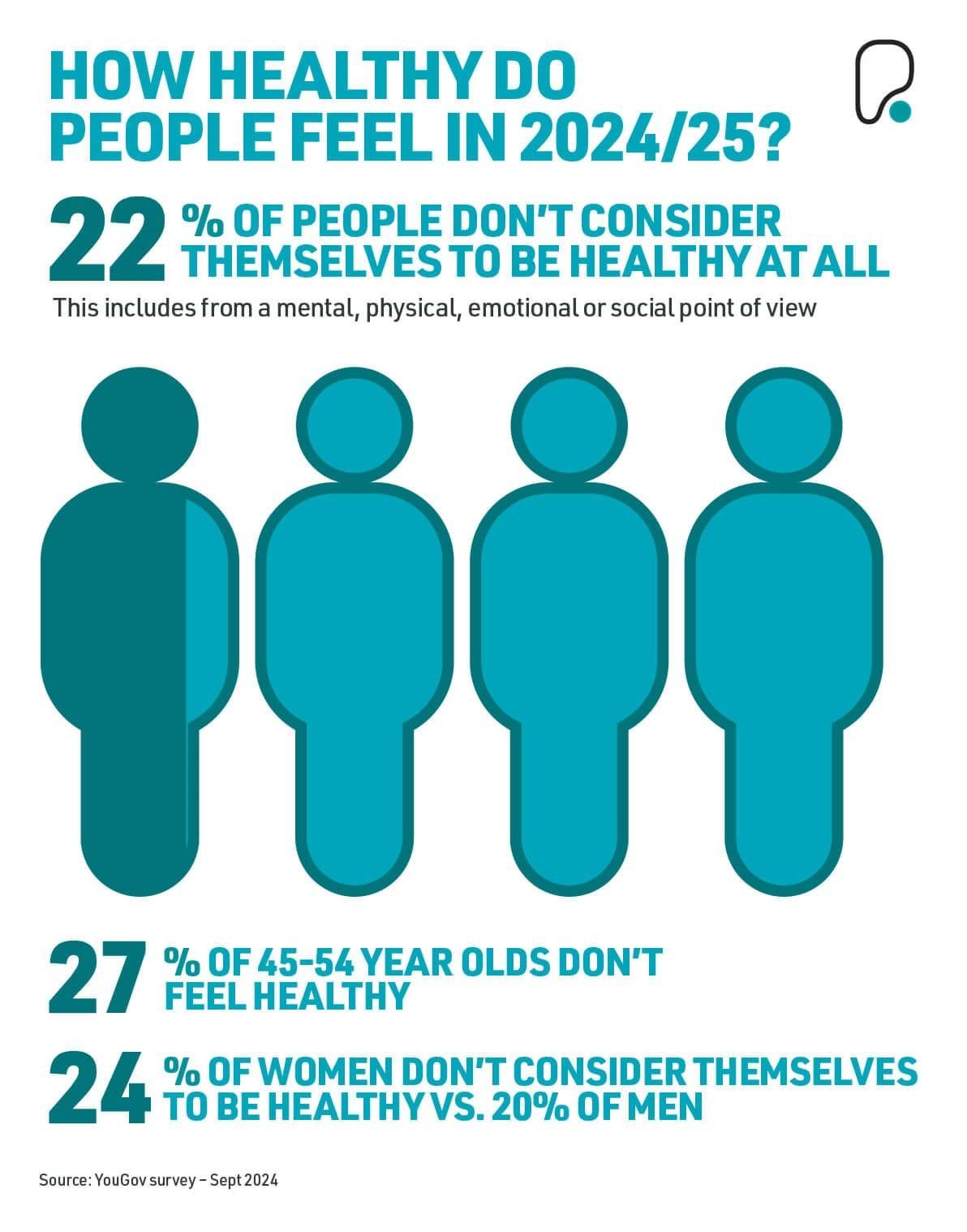
While our new data shows that things seem to be slowly moving in the right direction and that we're collectively feeling healthier than we did at the end of last year, there are areas holding the nation back.
What areas of health & fitness do people want to improve?
We asked people to pick out the key areas where they feel their health could improve the most, and while it's a close call between the top five, mental health and cardiovascular health came out top:
Mental health - 34%
Cardiovascular fitness/endurance - 34%
Strength - 33%
Flexibility/range of movement - 32%
Mobility/ability to move freely (e.g. standing, walking, sitting) - 30%
Just over half of the population (51%) say that they don't feel mentally healthy, so it's no surprise this came out as an area people want to improve.
With mental health and exercise going hand-in-hand, this is a topic we will be exploring throughout our report and have some great commentary on the subject from Mental Health UK within the 'Why Are People Exercising in 2024/25'.
How to improve cardiovascular fitness
Diving into the fact that 1 in 3 of us want to improve our cardiovascular fitness, one of our many experts on the subject, Macallum Livock, Gym Manager at PureGym York says that 2025 can be the year of good cardio, with some simple changes.
"It's interesting but unsurprising to see that 34% of people feel cardiovascular fitness is their biggest area for improvement. Many do struggle with endurance due a combination of a more sedentary lifestyle and lack of proper training.
"To enhance cardiovascular fitness, people can start by incorporating activities into their daily routine, such as a brisk walk or bike ride to work, rather than driving to work or taking public transport. It may sound small, but you'll find that it not only increases cardiovascular fitness but will save you some money as well. From there, you'll also have a better base level of cardiovascular fitness to take on more intense forms of exercise, such as running or swimming, if you wish."
How to improve strength
1 in 3 also feel that strength is an area they need to improve on, with women in particular (36% versus 30% of men) feeling that they could get stronger. Any form of regular resistance training can help to build strength, and you don't need a gym membership to do so. Bodyweight training or using resistance bands can help to build strength at home, and yoga and Pilates classes can also help to build strength as well as weightlifting and other forms of exercise.
How to improve flexibility and mobility
Finally, both flexibility and mobility are areas that millions of people feel they could improve. In particular, people that are later in life pinpoint these as areas for improvement, with 38% of people aged over 65 stating they could be more flexible/have a greater range of movement, and 41% feel their mobility could improve.
There's a common misconception that flexibility and mobility declines as we get older, but the reality is that as we move less, we become less mobile. Utilising your full range of motion and dedicating time to your flexibility and mobility are ways that anyone, no matter their age, can make an improvement in these areas.
Macallum says "Gentle exercises like chair stretches, seated leg lifts, and the cat-cow stretch can be beneficial. It is important to note that doing too much can cause injuries, so take it slow when starting out, as this is a marathon and not a sprint. As you ease yourself in with regular stretching, you'll quickly start to notice that your flexibility and mobility will start to improve, enabling you to do more in your daily life, which will in turn help itself!"
THE CURRENT STATE OF FITNESS IN THE UK
Key Findings:
48% of people currently exercise in the UK (+3% from last year)
65% of people aged 25-to-34-years-old currently exercise
London is the region where people exercise the most (59% of Londoners currently exercise)
The East Midlands is the region where people exercise the least (44% of people in the East Midlands currently exercise)
Only 1 in 10 people meet the NHS recommended levels of weekly 'moderate' or 'vigorous' activity
89% of 18-to-24-year-olds do some form of strengthening exercise each week
68% of people in the UK suffer with fatigue
Less than half (44%) of people say that they feel physically healthy, but how does that translate into numbers of people who are exercising?
Again, it's a positive trend year on year, with 48% of people currently exercising - 3% more than in 2023. While this may sound small, it equates to approximately two million more people taking part in exercise in the space of just one year!
This progress is being led by millennials, with 65% of 25-to-34-year-olds exercising, followed closely behind by 61% of 18-to-24-year-olds. The fact that the majority of people aged between 18 and 34 are incorporating exercise into their daily lives goes to show how much of a priority fitness is starting to become in the UK, especially for young people. But outside of age, how does this look on a map? Is there a capital of the fitness fanatics?
Where in Britain exercises the most?
We know that nationally, 48% of people are currently exercising, but two regions manage to exceed that number and exercise more than the national average. 49% of people in the South East exercise regularly and beyond that, an impressive 59% of Londoners incorporate exercise into their lives, marking London as the only region where over half of the population are exercising.
Truly the capital of fitness in Britain, exercise is undoubtedly a priority for many in the city, evidenced by the growing number of London gyms, sports clubs and specialist activity centres available in each of its 32 boroughs.
Most other regions fall below the national average, with the Midlands ranking as the area that exercises the least - just 44% of people exercise across both the East and West Midlands.
Coincidentally, the East Midlands is one of the regions that has seen the biggest drop off in fitness-related spending within the last 12 months - a topic we discuss in detail in the cost of exercise section of this report.
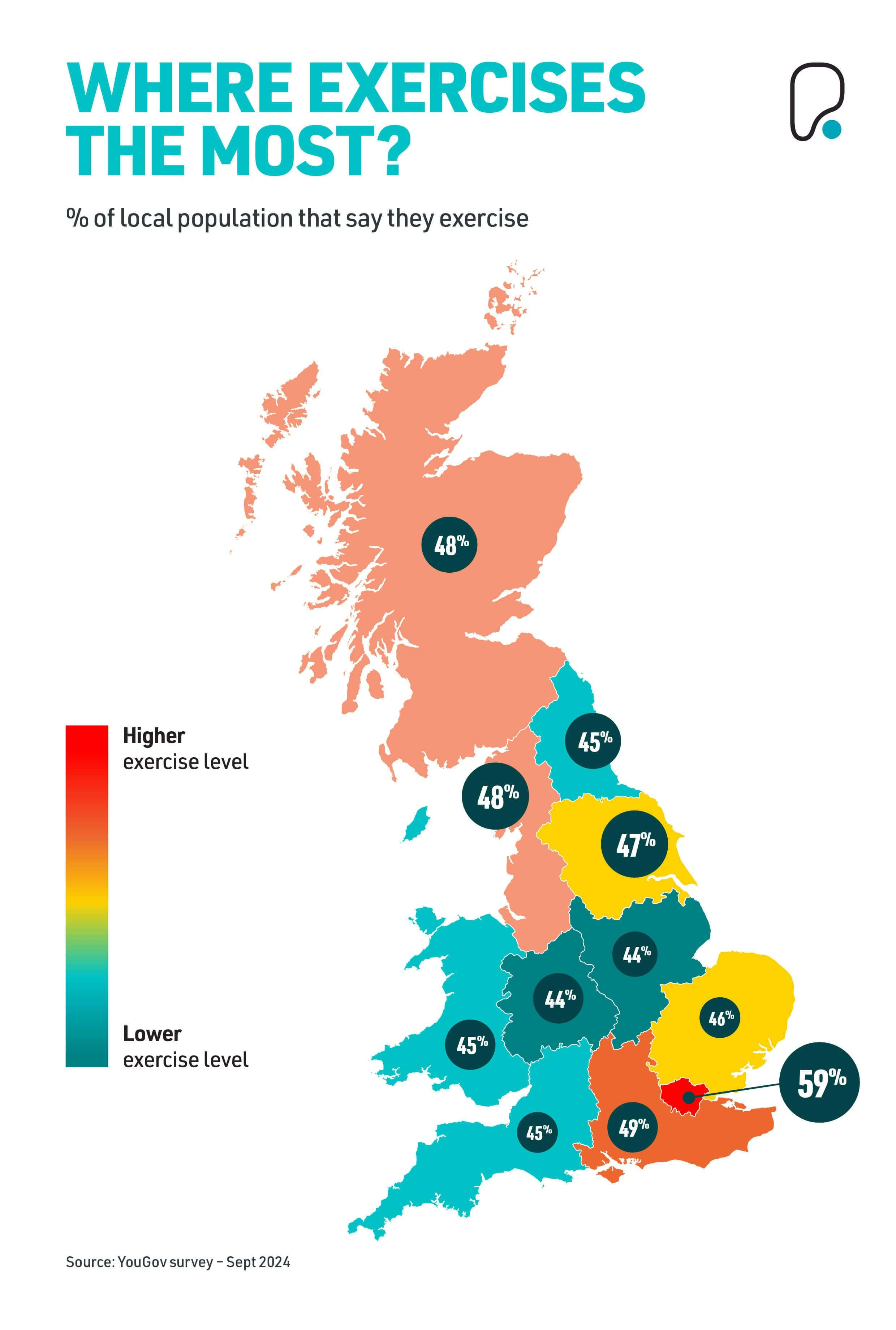
Do we meet UK government recommended levels of exercise?
Certain age groups and even regions are exercising more than others, but how can we tell that we're exercising enough and beyond that, doing the right forms of exercise? The UK government provides some useful benchmarks around this that can be used as a guide, with the NHS website stating that people aged between 19 and 64-years-old should aim to:
- "Do strengthening activities that work all the major muscle groups (legs, hips, back, abdomen, chest, shoulders and arms) on at least 2 days a week"
- "Do at least 150 minutes of moderate intensity activity a week or 75 minutes of vigorous intensity activity a week"
- "Spread exercise evenly over 4 to 5 days a week, or every day"
- "Reduce time spent sitting or lying down and break up long periods of not moving with some activity"
The guidelines also state that 'weekly activity targets' can instead be achieved with:
- "Several short sessions of very vigorous intensity activity"
- "A mix of moderate, vigorous and very vigorous intensity activity"
For this year's report, we wanted to see where we all sit against these weekly activity targets. By surveying the nation, we found that just 1 in 10 (10%) people meet the target of completing at least 150 minutes of moderate intensity exercise, which covers activities such as cycling, hiking, dancing, going for a brisk walk or even mowing the lawn.
The same goes for 'vigorous' exercise, again with only 1 in 10 people meeting the 75 minute per week guideline of activity that includes running, swimming, gymnastics or playing a sport such as football or rugby.
It's safe to say that these numbers are much lower than we would want them to be, however our research does reveal that we are potentially closer to some of the other targets laid out by the government. In particular, strengthening exercises continue to grow in popularity, with just over a quarter (26%) of people spending at least 45 minutes per week carrying out strengthening exercises. To break that down even further, 18% complete at least an hour of strengthening exercise, and a huge 89% of 18-to-24-year-olds do some form of strength exercise every week - again highlighting the growing fitness movement within younger age groups in the UK.
Similarly, 29% of the population complete at least 30 minutes of 'very vigorous' exercise. While this might fall short of the several sessions outlined by the government, it is encouraging to see that almost a third of us are completing at least some form of exercise that could include circuit training, a spin class or lifting heavy weights, on a weekly basis.
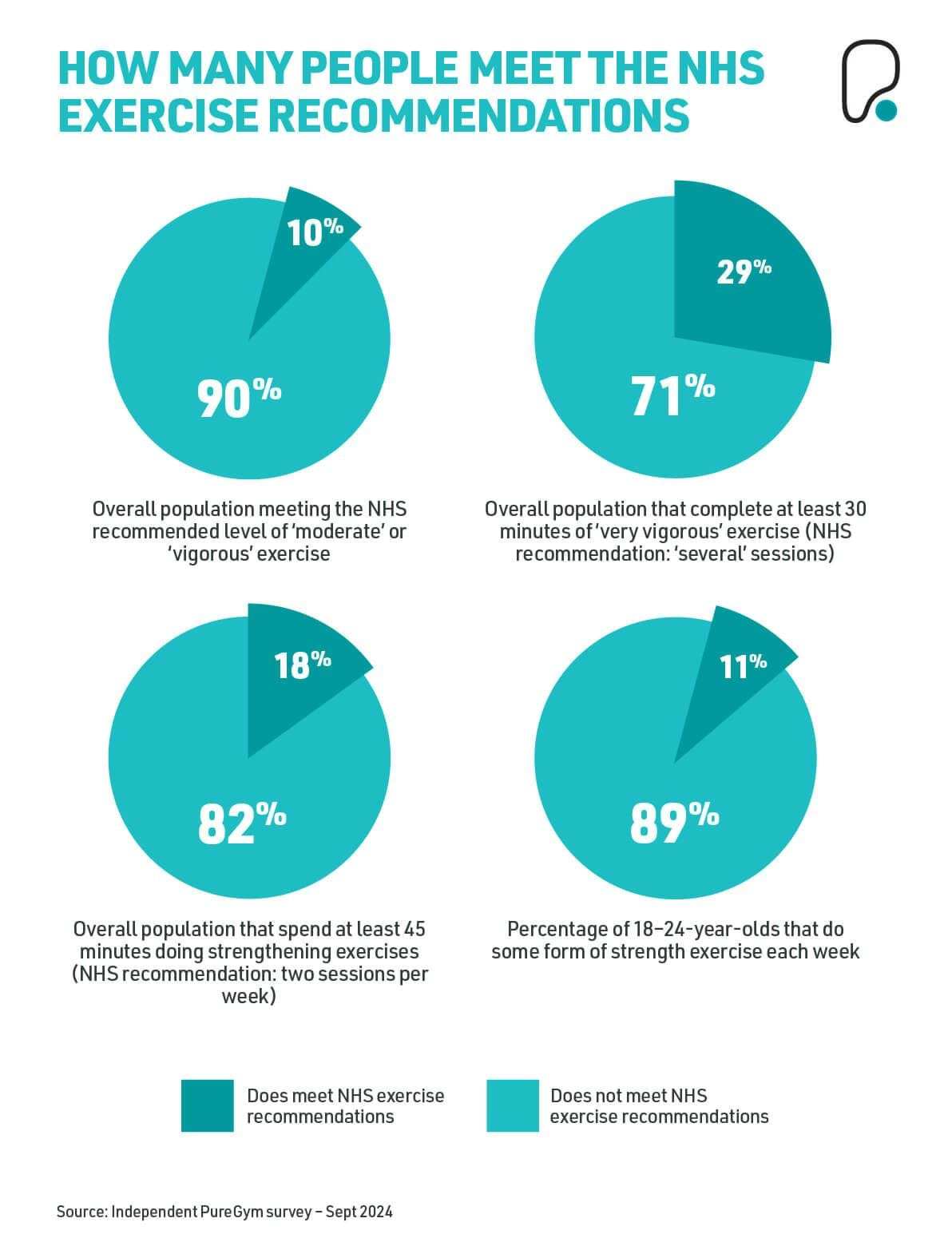
But with so few of us reaching the fundamental 'moderate' or 'vigorous' weekly activity levels laid out by the government, why is it important to place more of a priority on this, within our weekly routines? We tap into the many benefits of exercise shortly, but Senior Cardiac Nurse Ruth Goss from the British Heart Foundation discusses why this is so important from a medical point of view:
"We know physical activity benefits heart health which is why it's important for people to try and achieve the recommended amount per week. When it comes to your heart, exercise can reduce your risk of heart and circulatory diseases by up to 35%. Exercise can improve symptoms in some cases, and help reduce your blood pressure and cholesterol levels, which lowers your risk of having a heart attack or stroke."
Concerned that you're not getting enough exercise and fall below the government's recommendations? Brian Shea, PT at PureGym Edinburgh weighs in on how to hit those recommended activity levels.
"Depending on your lifestyle, it can feel overwhelming to fit this amount of exercise in, but there are some things you can do.
"If you're short for time, my first recommendation would be to simply walk as much as you can and start moving as much as possible. A great, time efficient way to achieve this is to find an active hobby or class you enjoy, that can be done within around half an hour - potentially on your lunch break. For example, if you find that your lunch breaks are currently mostly stationary, try swapping that for a brisk walk to increase the movement within the day".
"As for time efficient strength training, I would recommend dedicating just one or two hours per week to this. There's many workout plans that train all major muscle groups within an hour, affording you the time to complete this once or twice a week".
"However, if you feel you've got more time available for exercise each week, I recommend:
3-4 strength/weight training days
1-2 'moderate exercise'/cardio training days
"This is of course dependent on your current fitness level, however your weight training days could be split between 2x lower body and 2x upper body strengthening sessions - or alternatively, 3x full body workouts. Then, the moderate exercise/cardio days could include a run, bike ride or fitness class. It's all about finding what you enjoy and then starting by making sure you are moving more each week".
What are people struggling with the most?
Our survey results show that meeting most of the weekly activity targets laid out by the UK government are currently a struggle for many, and we already know that areas such as mental and cardiovascular health are areas people want to improve.
However, we wanted to break this down even further and identify what exactly people are struggling with the most that are preventing them from getting enough exercise.
What do people struggle with the most?
- Feeling fatigued - 68%
- Getting enough sleep - 66%
- Back aches/pain - 65%
- Poor flexibility - 63%
- Coping with stress - 63%
- Running a short distance (e.g. to the bus stop) - 63%
- Stiff or tight muscles - 62%
- Walking up a gradient - 61%
- Consuming too many calories - 58%
- Snacking too much - 57%
- Getting up from sitting on the floor - 55%
- Getting out of breath walking upstairs - 48%
- Recurring injuries such as muscle strains - 47%
- Eating enough protein - 46%
- Eating fruit and vegetables every day - 45%
- Drinking water - 42%
- Getting up from the chair/sofa - 39%
- Walking a short distance (e.g. to the shops) - 38%
- Moving neck side to side/up and down - 38%
- Consuming enough calories - 37%
Fatigue is something that impacts all areas of health and is currently the number one issue people in the UK are facing. It's clear that there's a serious fatigue problem within the UK and its one that is worse for women. 73% of women say they struggle with fatigue versus 63% of men, while a similar number of 35-to-44-year-olds struggle with fatigue too (74%) - more than any other age group. It's highly possible that this is related to the ever-growing demands of modern working lifestyles, something we discussed at length within last year's report, as the 68% of people struggling with fatigue coincides with 66% of people that struggle with getting enough sleep. It may also link to many of the other issues outlined in the research, such as struggles with stress (63%), eating enough fruit and veg (45%) and drinking enough water (42%). All of which are discussed at length later in this report - head to our nutrition section if you are interested in learning about the amount of fruit, veg and water people are currently consuming.
While this data does paint a picture of a nation struggling with its health, these numbers are more positive than similar research we ran in April 2023. While there's a long way to go, less people are now struggling with many aspects of their health, including struggling with walking a short distance (down 8% since April 2023).
This is again likely down to the fact that more people are prioritising exercise than they were just one year ago, helping people to feel more mobile and manage day-to-day tasks easier. But is that the sole reason people are starting to exercise more? Let's find out...
WHY ARE PEOPLE EXERCISING IN 2024/25?
Key Findings:
49% of people exercise to improve their overall health
34% of people exercise to improve their mental health
Less people feel they need to prioritise their appearance than in 2023 (27% of people in 2024 versus 35% in 2023)
13% of people are inspired to exercise due to a health professionals' recommendation
The Olympics/Paralympics inspired 6% of people to exercise, equating to more than four million people in the UK
The main benefits people see from exercise include having more energy, feeling happier, finding their mood has improved and losing weight
A lot of people who exercise have goals in mind to keep them going, and the most common exercise goal in 2024/25 is a great one! Simply 'improving overall health' takes the top spot as the goal most people are aspiring towards, with 49% of people that exercise picking this out as a reason they exercise. Exercising for health can help to improve day to day life, improving many of the struggles above such as poor flexibility and mobility, and getting out of breath when walking up the stairs.
Beyond this, improving mental health is the second most common reason people are exercising. We mentioned earlier that mental health is the number one thing people want to improve when it comes to their health, and this data shows that just over a third (34%) of people are using exercise to make that positive change.
Prioritising good physical and mental health is essential, so we're really pleased to see this being echoed in the results. Aesthetic based goals do also feature in the rankings, with more than 1 in 4 (27%) exercising to feel happier with their appearance - tying in with those that want to build muscle and feel more confident. However, this is significantly fewer than the number of people who were prioritising their appearance in our previous research, with 35% of people stating they wanted to feel happier with their appearance at the end of 2023.
When looking at how this breaks down between genders, we can see that losing weight is more of a priority for women (39% of women list this as a priority versus 27% of men) in addition to working towards feeling more confident. 29% of women are prioritising confidence as a 2025 exercise goal, while 18% of men are.
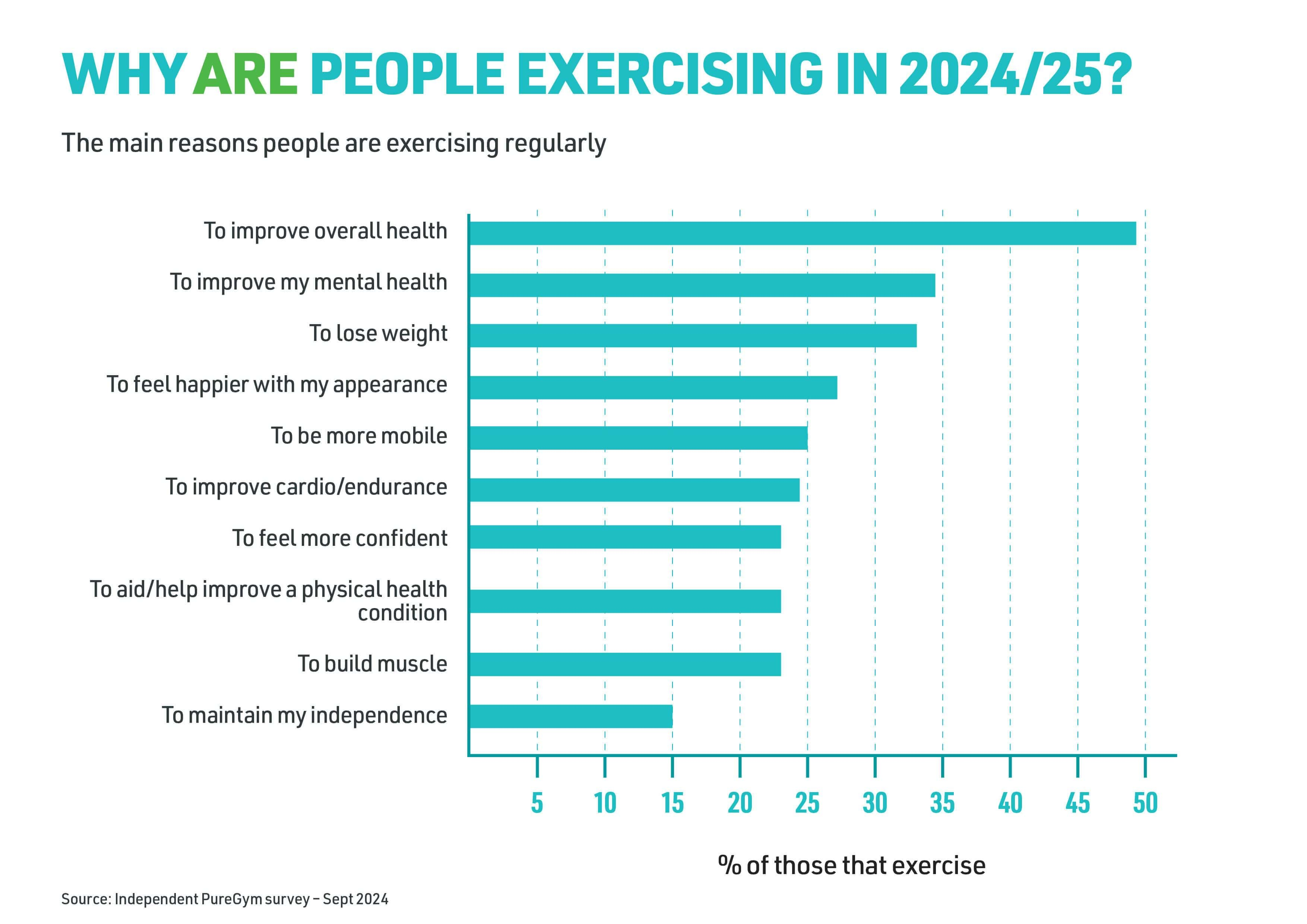
What inspires people to start exercising?
We've covered the main goals people have when it comes to their own exercise routines, but what about that initial inspiration to join a gym, head outside and start running or find a home workout?
Having a catalyst moment in how we feel, such as getting out of breath whilst walking up the stairs, is the main reason given, with 28% of people citing this as what inspired them to start exercising. This was certainly the case for Allison Rodger, the winner of our 2023 Over 50s Fitness Championships, who told us how arriving late for the bus one day was the start of her fitness journey:
"The fitness of my youth got a bit lost in time and resulted in weight gain and very little activity as I reached my late fifties, until one moment in particular made me make a change for the better. I had to run for the bus, but when I made it, I was so out of breath I said to the driver 'I really need to do something about this'".
"Since then, I joined a gym and have gone from not knowing how to use any of the equipment, to getting stronger and faster than people decades younger than me!"
Interestingly, with 2024 also marking the year of the Paris Olympics and Paralympics, we found that 6% of the population have been inspired to exercise following watching it - amounting to approximately four million people inspired to get moving by the many amazing athletes involved in the Olympic games.
The 10 things that inspire people to exercise the most
Own awareness of fitness (e.g. getting out of breath when walking up the stairs) - 28%
Want to be more active for my children - 13%
A health professionals recommendation - 13%
A health scare in the family/with a friend - 12%
Seeing people I know looking fit/healthy on social media - 11%
A life change (e.g. starting a new job, university or moving somewhere new) - 11%
Encouragement from friends - 10%
Encouragement from partner - 9%
Inspired to try a sport/workout from a TV show/film - 8%
Seeing other people I know exercising on social media - 8%
With more than 1 in 10 people being inspired to exercise due to a health professionals' recommendation or a health scare within the family, Ruth Goss from the British Heart Foundation discusses the importance of listening to your own body, but also the warning signs to look out for if you are concerned about hereditary conditions relating to the likes of heart health.
"If you're worried about your risk of developing a heart condition, either because you have had symptoms, or a family member has a condition, the best thing you can do is to think about your own heart health. This includes looking at your lifestyle - what your diet is like, what your blood pressure is, stopping smoking if you're a smoker. There's lots of things to consider".
"Then, if you find areas where you could make different and healthy choices, you can start making changes, ultimately improving your heart health".
"However, if you start noticing any new or worsening symptoms, it is important that you get these checked out. If you experience chest pain, shortness of breath or are tiring more easily than usual when exercising, then you should get this checked out. If you are living with a heart condition and you're worried about exercising, check in with your doctor for what exercise will be best for you."
What benefits do people see from exercising?
The proof really is in the pudding, so we wanted to find out from the people that do currently exercise, what benefits they have seen since starting.
In what might be our favourite part of this entire report, the benefits of getting moving and exercising are clear, and many directly correlate with both common fitness goals and the aspects of daily life many of us are struggling with - 30% find they're more energised, 23% have lost weight, while 19% are feeling more confident.
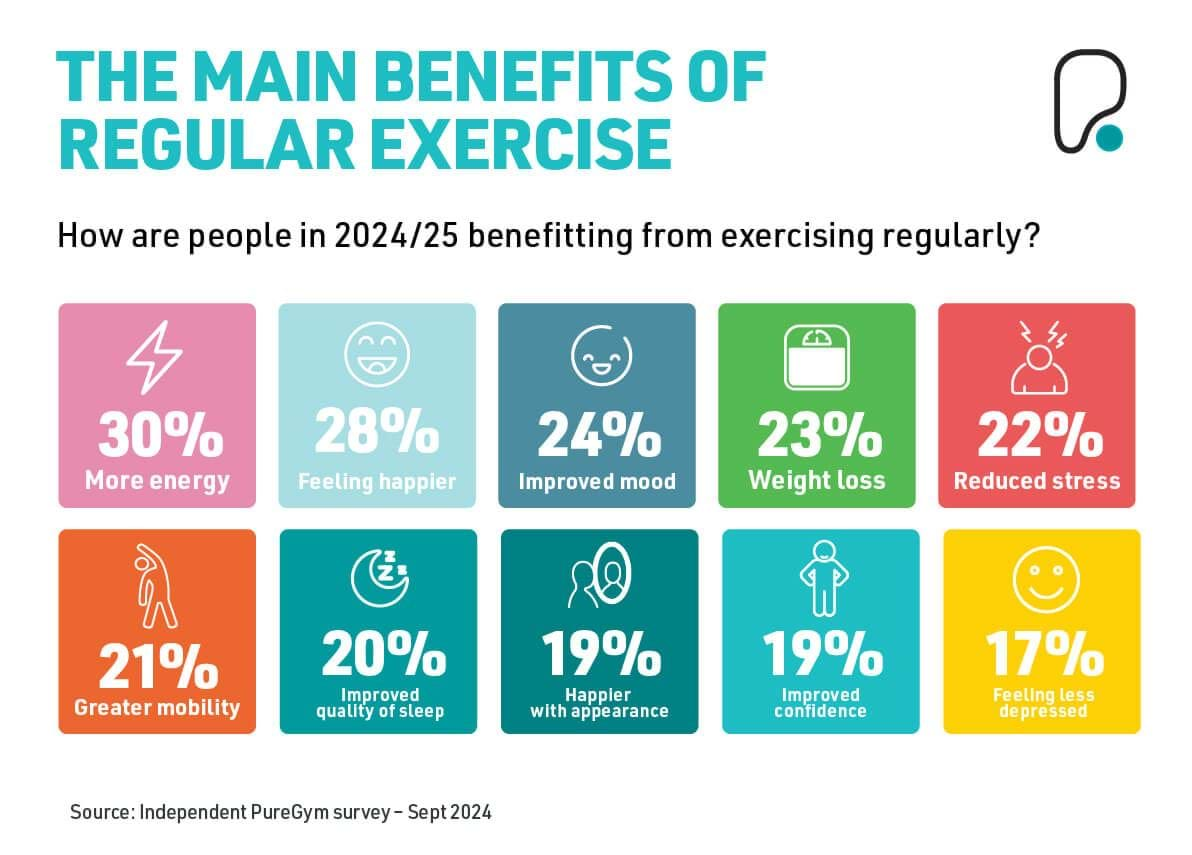
Arguably the most evident benefit of all however, is the overwhelming impact regular exercise can have on a person's mental wellbeing. People that exercise report feeling happier, less stressed, more confident and that their mood has generally improved - highlighting exercise as a great method for improving mental health.
To outline exactly why regular movement can be so valuable when it comes to improving mental wellbeing, we spoke to Charlotte Maxwell-Davies, the Head of Workplace Mental Health and Training from Mental Health UK:
"There are several reasons why exercise is beneficial for mental health. Physically, it releases endorphins, often called the "feel-good" hormones, which can improve mood and reduce stress. Regular movement also promotes better sleep, which is essential for mental wellbeing. Psychologically, exercise can provide a sense of routine and control, and accomplishing small goals can build confidence and boost self-esteem. Additionally, being physically active can help distract from negative thoughts and offer a positive way to channel stress.
"It's not about intense or vigorous exercise either - gentle activities like walking, yoga, or even stretching can make a real difference!"
"From what we've seen, particularly from working with those with lived-experience of mental health struggles, exercise can help reduce feelings of anxiety and depression, boost self-esteem, and provide a sense of accomplishment. It's not a cure-all, but it can certainly be a valuable part of someone's mental health toolkit. "
WHY AREN’T PEOPLE EXERCISING IN 2024/25?
Key Findings:
1 in 5 people (20%) don't exercise because they dislike exercise itself
13% of people don't exercise because they find it boring
Physical health conditions prevent 19% of people from exercising, while 8% say their mental health is a barrier
Fewer than 1 in 10 people (8%) now find the gym intimidating, a significant drop from 21% in a single year
Women are more likely to experience 'gymtimidation' (10%) than men (6%)
Exercising in front of other people is the main reason (70%) that people feel intimidated by the gym
As our findings above show, the many benefits of regular exercise are clear. However, we recognise that there are significant barriers to keeping active, and they can vary immensely from person to person. Understanding these barriers is the first step towards removing them and helping the nation to find more movement in their daily lives so that they can get the benefits of exercising.
As with last year, the most significant barrier to exercise is an outright dislike of it, with 20% of the population feeling this way towards activities such as working out, playing a sport, or even going for a walk and another 13% citing finding exercising boring as the reason they don't. A significant 19% of people find that their health conditions limit their ability to exercise - a figure that is sadly up 4% compared with this time last year.
For those who dislike exercise, or find it boring, this could stem from past experiences, like childhood P.E. lessons, or negative adult experiences that have discouraged them from trying again. It may also be from not knowing the different ways to exercise - there are plenty of unique and fun ways to get fit if running or the gym isn't your thing. Ultimately, these insights underscore the need to find accessible, enjoyable ways to stay active - ensuring that everyone can find what works for them when it comes to moving our bodies. Hopping aboard a new fitness trend that offers a fresh twist on exercise could be a great way to combat a dislike of exercise and find a form of fitness that suits you. Skip ahead to discover the trends set to take 2025 by storm!
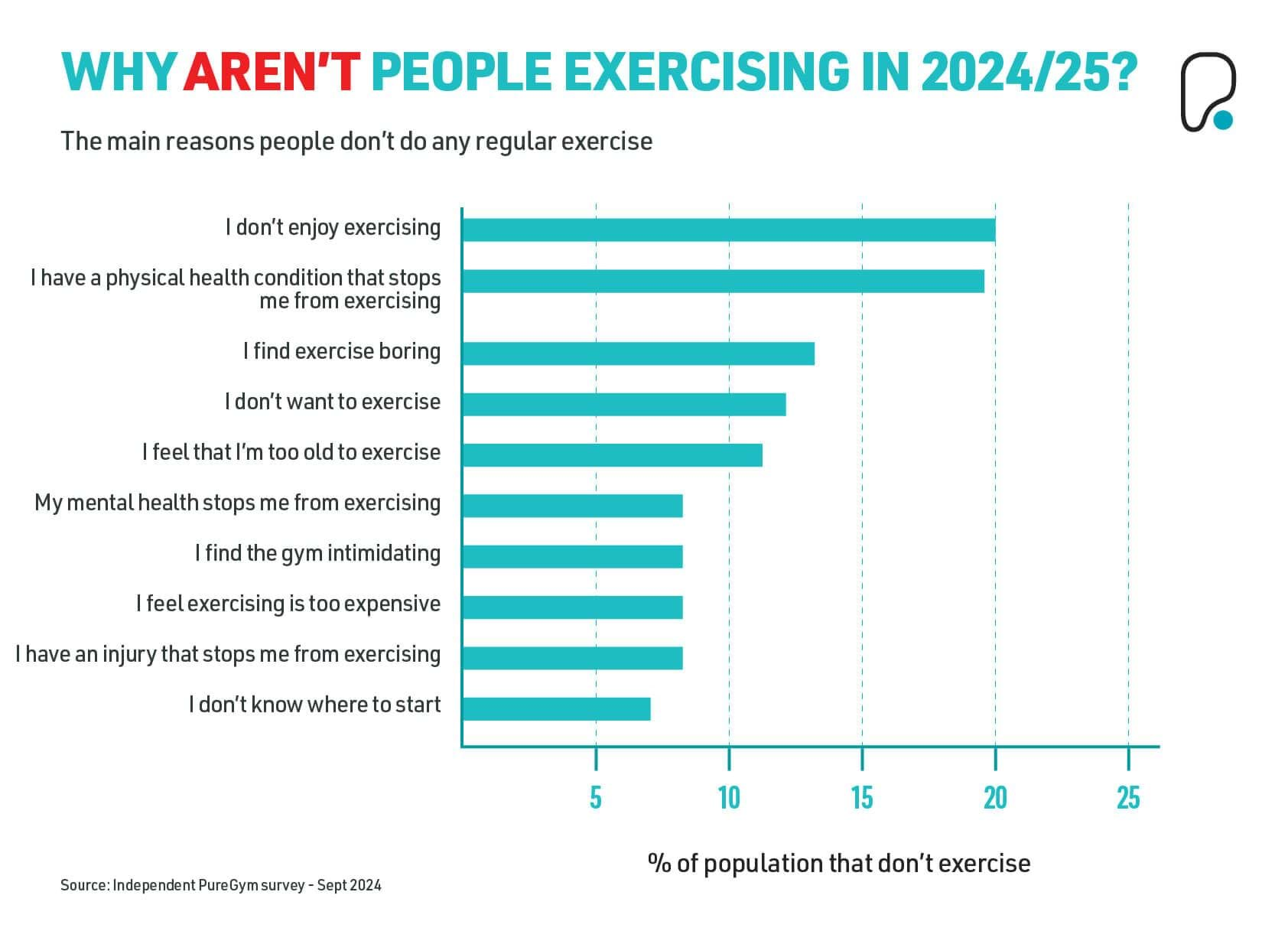
Are people scared of the gym?
In previous editions of this report, we have investigated just how much a fear of the gym impacts how likely people are to join one and use it as a base for their activity. The gym remains one of the most popular places for people to get their exercise in, whether that's through joining classes, working with a personal trainer, or independently working out using the equipment provided.
Gymtimidation affects far fewer people now (8%) compared to last year (21%), showing great progress in more people feeling comfortable in a gym setting. However, it still remains a significant issue - especially for women and younger people. More women experience it (10%) than men (6%), and it's those aged 18-to-24 who feel it the most too, with 13% saying they feel intimidated by the gym - more than any other age range.
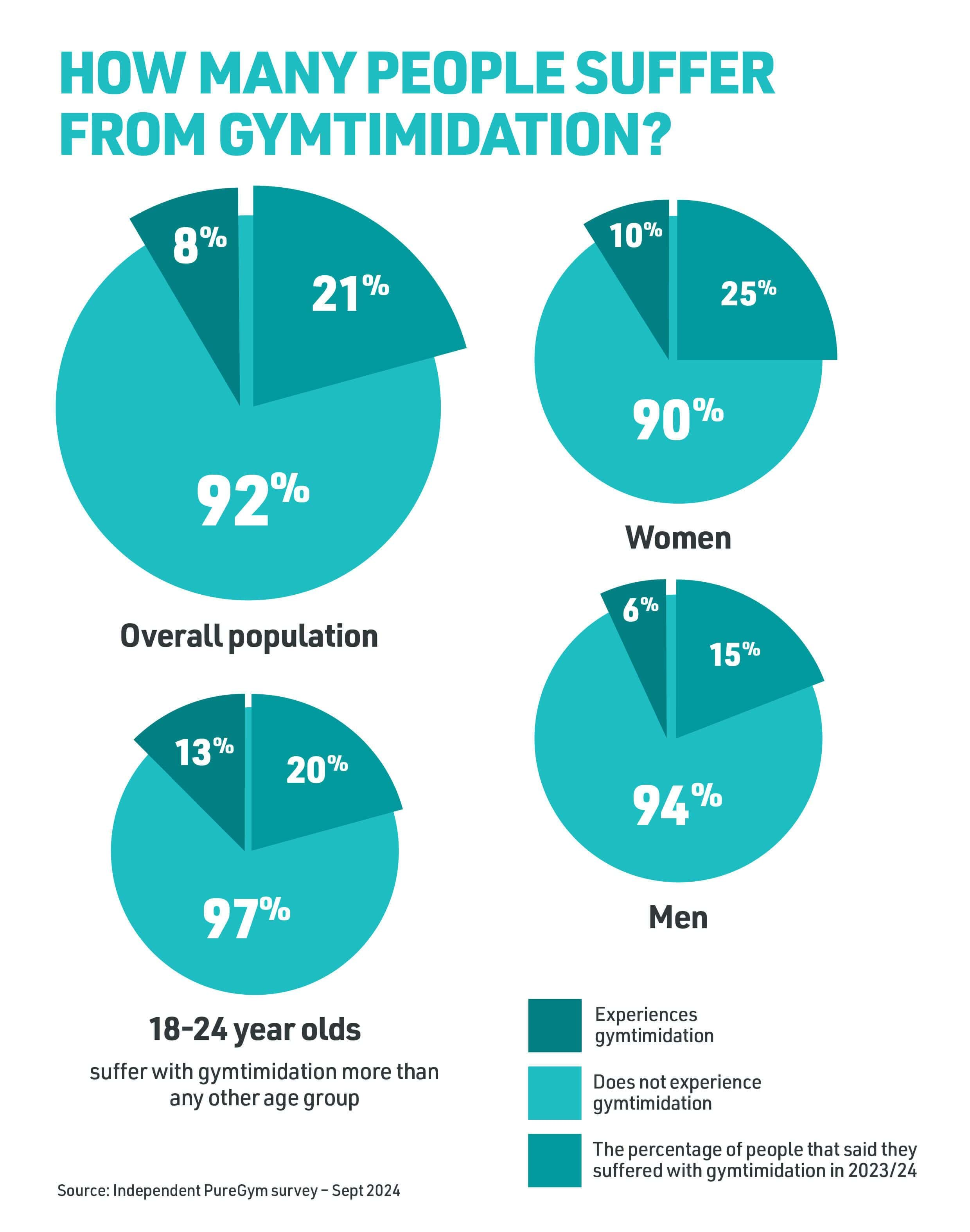
With some people still suffering with ‘gymtimidation’, we’ve delved deeper to understand the causes of these fears and provide actionable ways to combat it for the 8% who still don’t feel fully confident at the gym.
The primary reason for this is exercising in front of others, with over two thirds (70%) of people of the that say they find the gym intimidating citing this as a source of their intimidation. This is followed by not knowing how to use the equipment (61%) and feeling that the gym isn’t a place they belong (56%). Interestingly, men are more likely to feel that they don’t belong in the gym (65% of men versus 51% of women), while women are more likely to be intimidated by other gym users (54% versus 35% of men).
Among 18-to-24-year-olds, the age group that experience gymtimidation more than any other, exercising in front of people is the most intimidating aspect of the gym, with 86% citing this as the key reason.
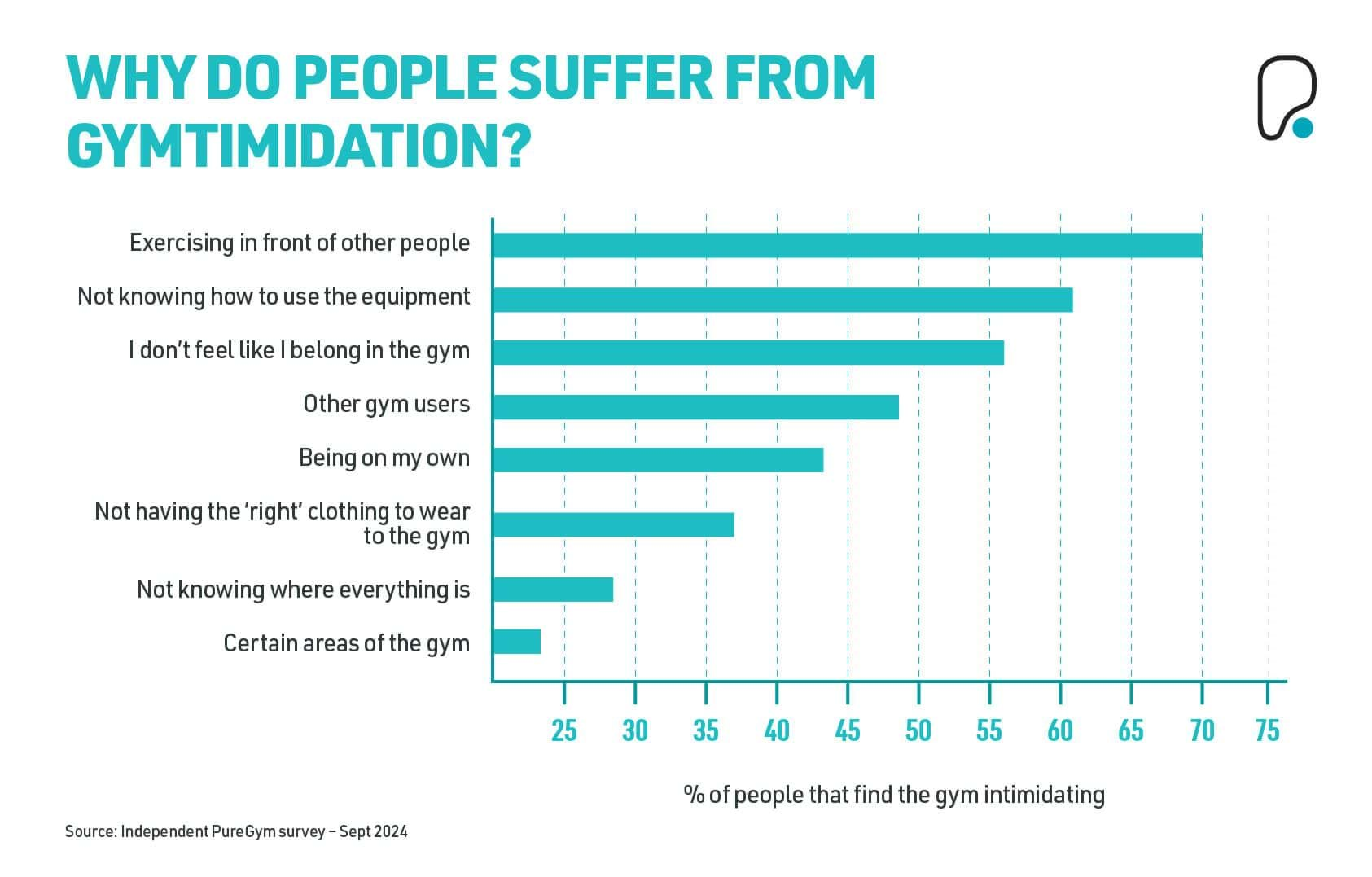
Reducing gymtimidation is something we're passionate about and have been working to make PureGym a place to have fun and reach your personal goals in an inclusive environment, where everybody truly is welcome. With this in mind, we've spoken to Claire Phippen, a PT at PureGym Norwich, to get her top tips on how people suffering from a lack of in-gym confidence can beat it once and for all and take that remaining 8% down to zero!
Join group classes
While it may seem counterintuitive, with many citing exercising in front of others as a concern, joining group classes can in fact be an effective way to feel more confident at the gym, as Claire explains: “Research has shown that group environments can foster a sense of community and support, significantly reducing feelings of intimidation (Carron et al. 2020). But further to this, attending classes led by knowledgeable instructors can provide guidance on equipment use and proper form, helping to quell those anxieties around not knowing what to do. If you feel really nervous, try arriving earlier to class to help you acclimate to the environment before the session gets going.”
Build up your workouts slowly
Certain exercise trends have been created to help people find their feet at the gym. For example, the ‘shy girl workout’ which focuses on creating a workout plan that sticks to one area of the gym, can be a valuable approach for beginners who feel anxious about using gym equipment. Claire explains: “Our research has shown that a significant portion of individuals feel intimidated by equipment use, so engaging in familiar exercises on a mat can go a long way to help you build strength and confidence, allowing you to transition to more advanced workouts once you feel more comfortable”.
“Recent research supports this approach, indicating that starting with less intimidating workouts can enhance self-efficacy and make the gym experience more enjoyable (Biddle et al., 2019).”
Remember you’re not alone
Although the number of people who say they experience gymtimidation has dropped this year, it has been high in previous years – suggesting that more people are overcoming their fears all the time. It can be done, and it means that other, more experienced gym members, will remember what it was like to have that fear. Claire suggests that “simple interactions, such as greeting fellow gym-goers, or asking for advice, can initiate friendships and create a welcoming atmosphere.”
“Research emphasises that social support in fitness settings can improve motivation and adherence (Sallis et al., 2021). Current gym members can also assist newcomers by offering to demonstrate equipment use or sharing workout tips, while being mindful of personal space and comfort levels. Such small gestures can significantly boost a newcomer’s confidence, making them feel more at home in the gym environment.”
Avoid peak hours
PureGym is designed to make everyone feel at home, regardless of fitness level, says Claire. But visiting the gym for the first time during peak periods can make the experience more intimidating. Avoiding these peak periods, and planning your initial visits to coincide with times the gym is quieter and therefore more relaxing can help you ease yourself in. Try to tour the gym too, so you can get an idea of where everything is, before visiting when it’s busier.
If you're intrigued when the gym is at its busiest and quietest, head here to find out!
HOW OFTEN ARE PEOPLE EXERCISING?
Key Findings:
89% of people who exercise, do so at least once per week, up 2% from last year (87%)
39% exercise two to three times per week (up 5% YoY)
People take 2.5 rest days on average each week
Summer is the most popular time of the year for exercise, with 45% of people working out during the warmer months
Winter sees the lowest levels of physical activity, with three quarters (76%) of people choosing not to exercise during this season
People are most likely to increase their exercise levels in the run up to their wedding
Meanwhile parenthood and Christmas predictably see reduced exercise levels
Using data sourced from YouGov, we're able to see how long people that exercise, actually exercise for. The average sits between 30 minutes and the hour mark with the majority of people (39%) exercising for 30-59 minutes at a time, while a third (33%) exercise for one to two hours per session. However, as highlighted earlier in this report, consistency can often matter more than the length of a single session - with a regular level of physical activity throughout each week being what everyone should aim for.
On this note, when it comes to how frequently we're all exercising, it's fantastic to see that almost 2 in 5 (39%) people that exercise are doing so 2-3 times per week, which is up 5% compared with last year (34%). A further 24% work out four to six times per week, and 1 in 10 people say they exercise every single day.
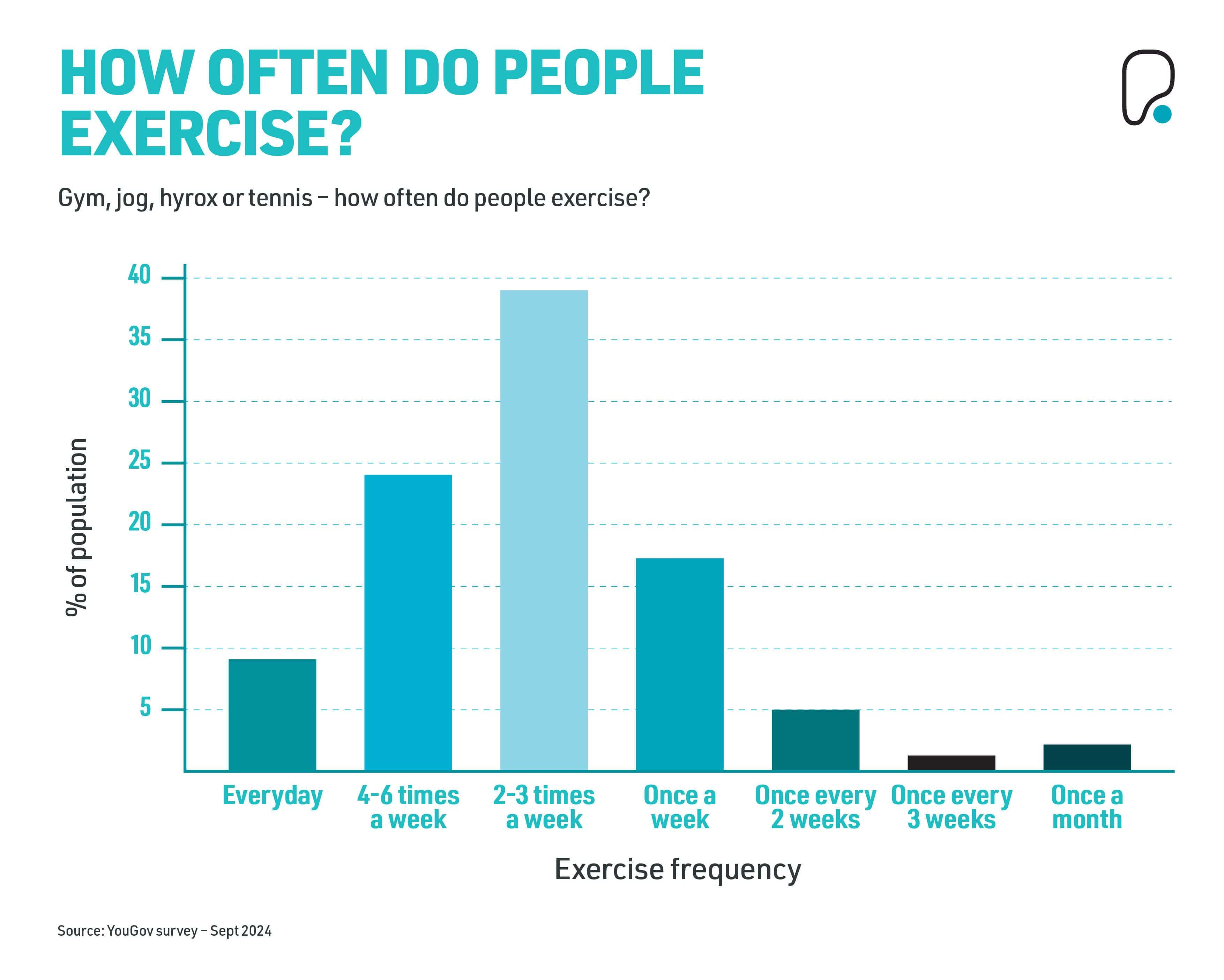
While it's great to see so many people who exercise are doing so regularly, elements of this data can result in a few questions: isn't exercising every day of the week excessive? Is there such a thing as too much exercise? What about rest days?
Tenzin Harley PT from PureGym London gives her expert opinion on this: "It's important to draw a distinction between exercise and training. Exercise can generally be defined as physical movement that promotes mental and physical wellbeing, whereas training is a programme designed to illicit a specific response in the body. "
"The human body is designed to move every day, so engaging in things like walking, stretching or low impact and general movement is definitely a positive thing. Training, however, is more strenuous and doing it every day certainly isn't necessary. Physical adaptations that result from training, happens when you are at rest. So, this means you should be giving your body enough time between sessions, as well as adequate protein and sleep, to get the most out of your training".
So, what does this look like in practice - are we all taking enough rest days to be maximising the impacts of our exercise or are we at risk of overtraining? Our research reveals that while the average amount of rest days people take each week is 2.5, 13% report never taking one, and a third (33%) don't view holidays as a break from their fitness routine either.
While the number of rest days each person needs will vary heavily depending on many different factors, it is well documented that are rest days important for injury prevention and reducing muscle soreness, and can also aid in muscle growth and strength gains, and everyone should be aiming to get rest every week. Tenzin stresses that overtraining will impact the quality of results you can get from your work at the gym: "A good rule of thumb is that if you're still experiencing DOMS (delayed onset muscle soreness) you should not train until it eases."
How do the seasons affect how people exercise?
As can probably be expected, the differing weather in the UK across the year brings about distinct differences in levels of exercise. At PureGym, we do see predictable spikes in gym usage at specific times of the year (more on that soon), but our research also reveals that the weather itself impacts all forms of exercise, from working out, to playing sports, or simply going for a walk.
While an average of 45% of people exercise during summer, this drops to 29% in the autumn and reaches a low of 24% people exercising during the winter. As the weather and daylight hours begin to rise activity levels tend to rise again in spring, with an average of 36% of people starting to undertake more physical activity while the weather warms up.
How do life events affect how regularly people exercise?
It's not just changes in weather that affects activity levels - many other life events can also have a big impact on how much or how little we exercise.
When asked which life events trigger an increase or decrease in the frequency of their workouts, nearly a quarter (24%) said a wedding would increase the amount they exercise - more than any other life event. Tying in with our data on the main reasons people tend to exercise earlier in this report, and the large numbers that exercise to feel happier with their appearance or improve their overall confidence, it's no surprise that activity levels tend to spike in the lead up to the big day. Likely for similar reasons, holidays follow closely behind, with 23% of people saying they work out more before jetting off.
Interestingly, almost twice as many women (29%) exercise more before their own wedding than men do (16%). However, men tend to increase exercise frequency more than women, when it comes to life events such as important meetings at work.
Conversely, the research reveals that parenthood has the opposite effect, with 18% of people saying they would reduce exercise in the lead up to it. This reflects the fact that new parents inevitably have far less time on their hands, with lack of free time consistently ranking in our research as one of the biggest blockers to exercise in general.
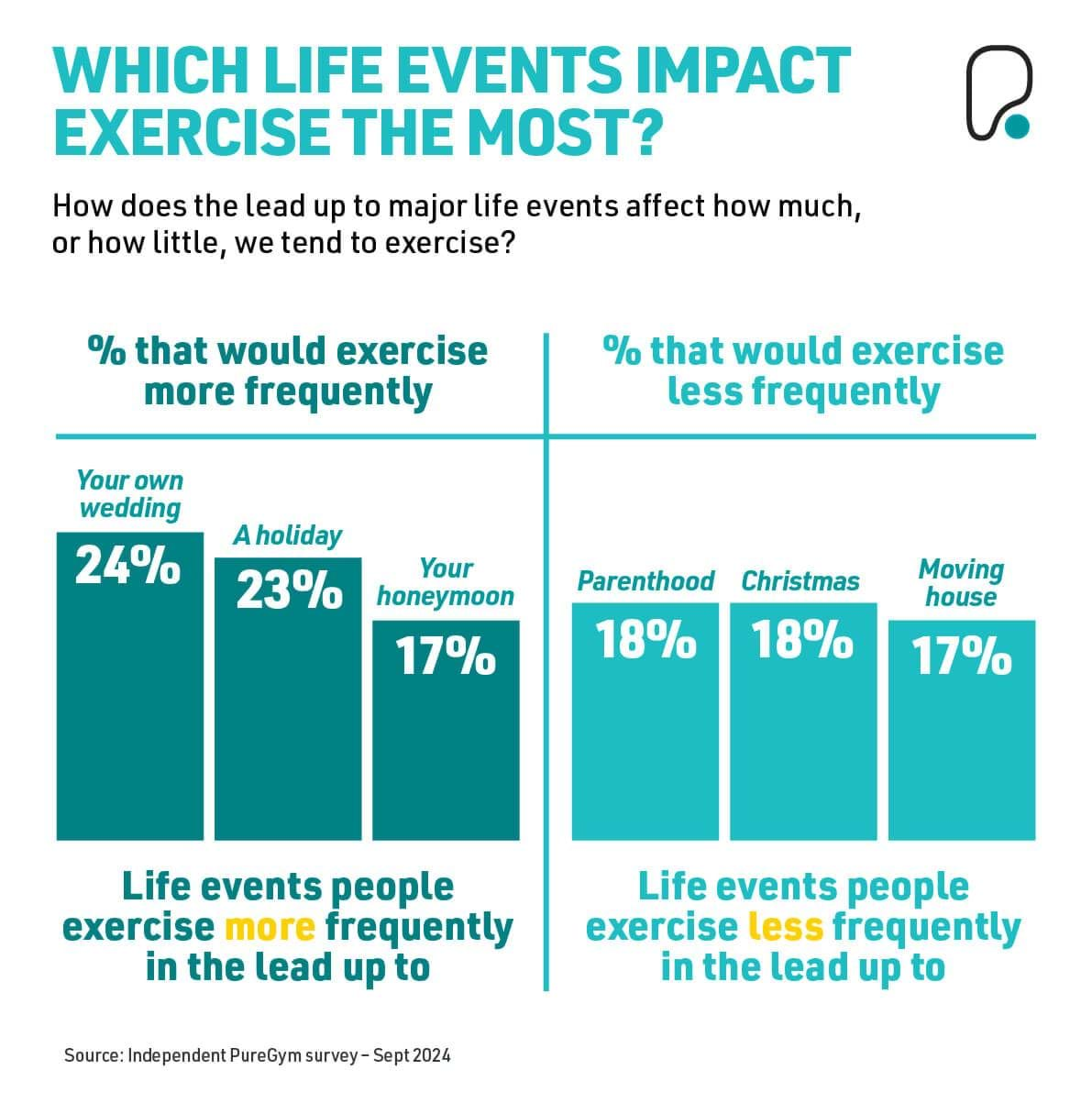
While we have mentioned this already within this report, it feels especially important to note that when it comes to various life events, it is not necessary to ‘get in shape’ for anything. The best rule of thumb to follow is simply trying to incorporate more movement into your day and to feel healthier for yourself, no matter when or based on what you feel other people might think.
2024/25 GYM USAGE
Key Findings:
17% of people in the UK are currently a member of a gym, up 1% year-on-year
25-to-34-year-olds are the age group most likely to be gym members (29%)
Men are more likely than women to be gym members (18% versus 15%)
The average gym visit lasts 1 hour and 9 minutes
A further 17% of people plan to join a gym in the next calendar year, which is also up 1% compared to last year
More men are planning on joining the gym within the next year than women (20% versus 14%)
Almost a third (30%) of people cancel their gym memberships due to cost
As we approach the end of 2024, 17% of people in the United Kingdom are currently members of a gym. Based on current population figures, this amounts to close to 12 million people!
Beyond this, a further 17% of the population tell YouGov that they plan to join the gym in the coming 12 months, a figure which has risen by 1% compared to this time last year - once again showing that as a nation, we are gradually, year after year, prioritising our health and fitness more. Specifically, it's men that are leading the charge here, with 20% saying they are planning to join a gym in 2025 compared to 14% of women.
Although this all paints a positive picture, it's worth noting that our research last year revealed that 16% of people were looking to join a gym within the next calendar year as 2023 came to a close. As gym memberships have only grown by 1% since then, we can expect that the actual increase in gym members during 2025 will be more of an incremental one.
It's worth noting that one of the reasons that the total increase in members doesn't match the number of people who say they will join the gym is some people will cancel their memberships during a calendar year. So, why do people make the decision to quit the gym?
Why do people quit the gym?
While there are a few reasons given for cancelling gym memberships, it's clear that the high cost of living within the UK has a huge impact on health and fitness aspirations. Cited as the number one reason people quit the gym, YouGov data shows that 30% of people have cancelled their membership because they found it to be too expensive. The cost of exercise is something we explore more within a dedicated section of this report, so head here is you want to learn more.
At PureGym, we're committed to providing great gyms at affordable pricing for this exact reason. Offering low cost, no contract memberships with various gym membership options for different budgets helps to make gyms more accessible and is something we stay committed to, nationwide.
Outside of cost, one in six (15%) state that a lack of time is the reason they stopped going to the gym, while 1 in 5 cite a change in personal circumstances, tallying up with previous data around stress, fatigue and life changes, such as becoming a parent.
The top 5 reasons people quit the gym
It was too expensive - 30%
My personal circumstances changed - 20%
I didn't have time to go anymore - 15%
I didn't like the experience - 7%
It was at times that were no longer convenient - 5%
How much time do people spend in the gym?
Of those that do go to the gym, the average gym visit sits at 69 minutes. A time that has stayed consistent during all three versions of our UK Fitness Report (2022, 2023 and 2024) and when taking into account time spent dropping off belongings into a locker or getting changed, is very much in line with the average 30-59 minute exercise time discussed earlier.
When at the gym, one thing that can add or take time off your stay, is how busy it is when visiting, so let's look at the busiest and quietest times to visit the gym...
THE BUSIEST AND QUIETEST TIMES TO VISIT THE GYM
Key Findings:
Tuesdays are the busiest day of the week in the gym
Sundays are generally the quietest day of the week at the gym, followed by Saturdays and Fridays
The busiest month to visit the gym is January
The quietest month to visit the gym is December
The quietest days at the gym outside of Christmas and New Year, are Easter Sunday and the late August bank holiday
However in 2024, the final of the men's 2024 European Championships between England and Spain was also particularly quiet (quieter than Father's or Mother's Day)
Cycle themed gym classes are the most popular with gym goers
While less people than ever find the gym an intimidating place to be, working out in front of other people is one of the main factors behind gymtimidation. Knowing when the gym is at its quietest can therefore be helpful in getting people through the doors. With that in mind, we wanted to take our annual look into when the gym is at its busiest and quietest.
Thanks to our internal data, we know that Mondays and Tuesdays are consistently the busiest days of the week in the gym, unchanged year on year. This likely is due to people feeling rested after the weekend and tying in their exercise with the start of a new week. Predictably, busyness levels then decline as we begin to reach a new weekend, making Sundays a particularly good time to head to the gym if you want to get used to the space and quell any feelings of gymtimidation.
For a live look at how busy you're nearest PureGym is, you can simply check the PureGym app.
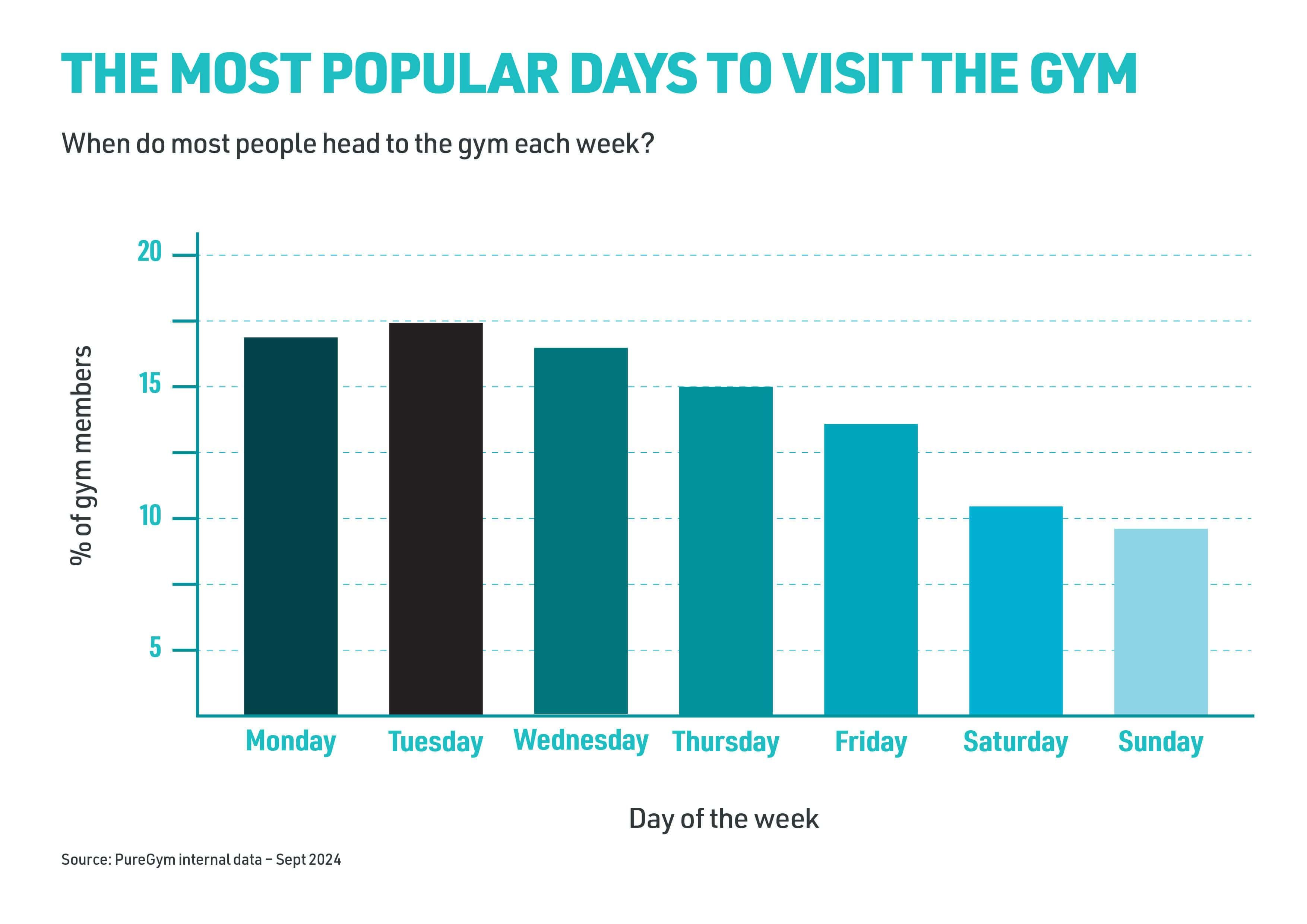
January has long been viewed as the month that many new gym members will look to sign up and tackle their New Year's resolutions, but interestingly it has not always been the most popular month for gym visitors. Looking at data from the previous two years, the busiest months have varied from March in 2022 to May in 2023, but in 2024 - visits did in fact peak in January. On the flipside, visits in September consistently tend to be low year-on-year, even with the emerging 'winter-arc' trend, that has seen an increased number of people kickstarting their fitness regimes ahead of the years-end, rather than in January.
While the month of January may have been the busiest overall, it's February and March that are consistently home to some of the busiest days in a calendar year, with seven of the top 10 busiest days of the year landing in February and March. This suggests that New Year Resolutions kick in a little later than January 1st, after the excitement of Christmas and New Year have died down.
Speaking of Christmas and New Year, these dates are unsurprisingly the quietest dates to visit the gym. Outside of this, Easter Sunday and the late August bank holiday are the two quietest days at the gym across the year. 2024 also saw the final of the men's European Championships on Sunday 14th July, which resulted in gyms being quieter than they are on Mother's or Father's Day!
Which gym classes are most popular?
Almost a third of gym members (32%) attend group exercise classes. These sessions are designed to help you achieve specific goals, learn new skills and build confidence, and they're a fantastic way to fight the concerns that come with not knowing how to use certain equipment.
Using our own internal class-booking data, we can see that Cycle retains its top spot from the last two years of this report, ranking as the most popular class across the board, making up 21% of all class bookings in 2024. Legs, Bums & Tums follows with 14% of class bookings and Pump rounds out the top three at 12%.
New to our roster of classes in 2024 and already available at gym locations such as Manchester and Liverpool, we're predicting that come the close of 2025, Hyrox classes will be well up the class rankings too, with our 2025 fitness trends predictions revealing yet another surge in popularity for the all-encompassing form of exercise.
DIET AND NUTRITION
Key Findings:
Just over half (53%) of the population feels they have a healthy diet, while almost a third (29%) don't
17% of people aren't sure what having a 'healthy diet' means
Brits are consuming just half of the minimum recommended amount of water per day on average, at 759 ml compared to the recommended 1.5-2.5 litres
Almost two thirds (64%) of Brits are eating less than the recommended five portions of fruit or veg per day
23% eat the recommended 3 balanced meals per day
A quarter of people (26%) currently count the calories they consume
A fifth of people feel that dietary supplements are a 'good' replacement for an unhealthy diet (22%)
What we eat and how much we're eating are common topics in the health sphere, and one that's particularly prominent at present, with discussions around ultra-processed foods (UPFs) currently running rife. Recent studies into the topic have shown that toddlers in the UK obtain almost half of their calories from UPFs; and with our data showing that almost 1 in 5 (17%) Brits say they're not sure what having a 'healthy diet' even means, it's clear that there's still a lot of confusion around nutrition.
Although just over half (53%) of the population feels that their diet is healthy, we wanted to take a closer look to see how much of a handle people really have on their daily consumption, and whether as a nation, we are hitting the recommended markers to keep our bodies sufficiently fuelled and hydrated.
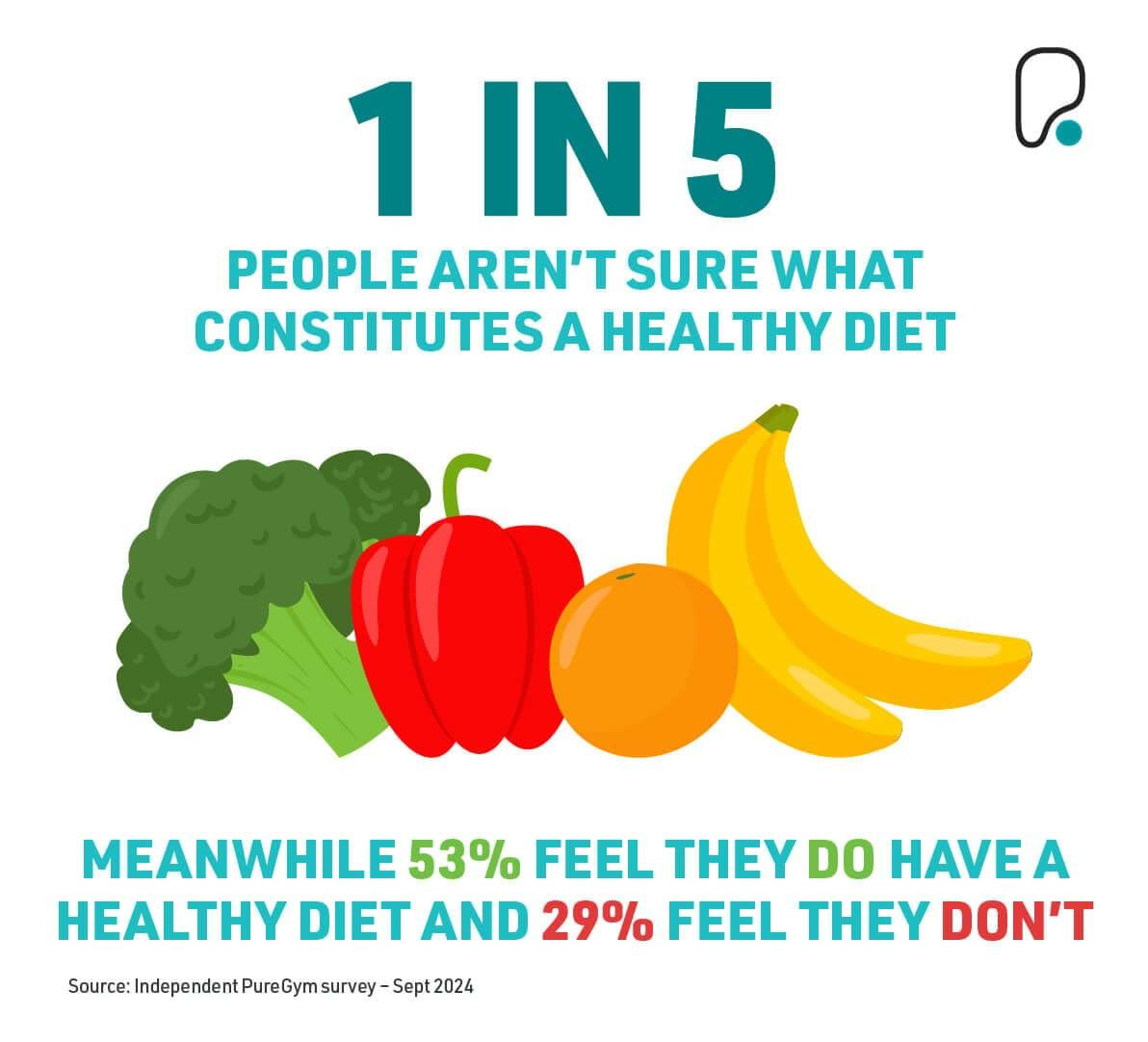
How do we feel about our diets?
Over half (53%) of the population feels that their diet is healthy, which is an improvement of around 5% from the 48% who agreed with the same statement last year. Of all age groups surveyed, almost two thirds (65%) of those aged 65 and over said that they believe they have a healthy diet, making the age group the most confident in their eating habits.
On the other end of the scale, 18-to-24-year-olds were least likely to share this sentiment, with 39% stating that they feel their diet is an unhealthy one. However, they're also the age group that appears to be the most uncertain about their eating habits, with 20% admitting that they feel unsure of what constitutes a healthy diet, slightly above the national average of 17%.
People who exercise also appear to have more confidence in their diet than those who don't with 3 in 5 (60%) saying they feel it's healthy, compared to just 38% of those who don't exercise on a regular basis.
Are we drinking enough?
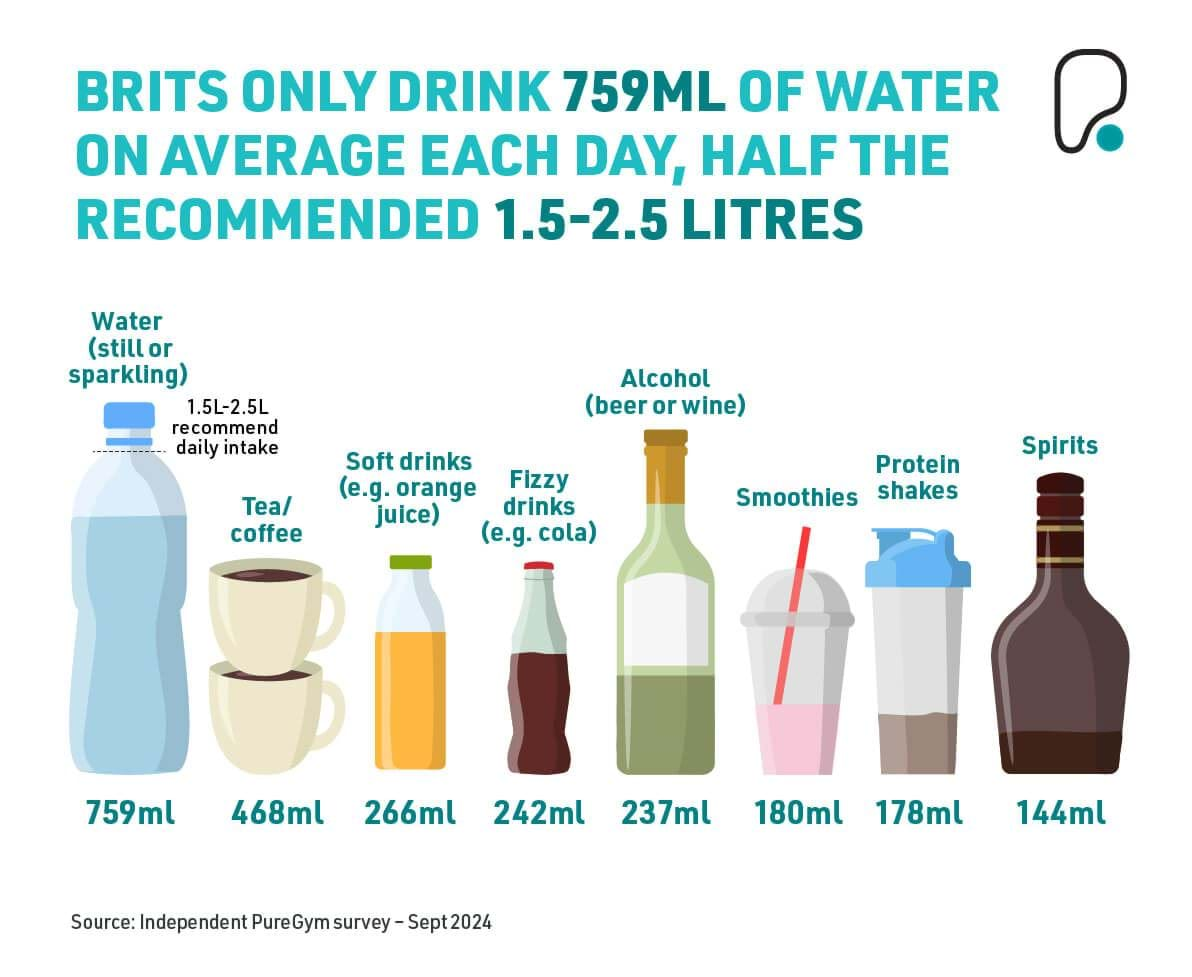
The importance of drinking water is something we learn about at a young age, and one that is constantly reiterated throughout our lives. However, it appears that many Brits don't pay enough attention to warnings around dehydration, with our average daily water consumption sitting at 759ml, just half of the NHS minimum recommended volume of 1.5l to 2.5l per day. Even 18-to-24-year-olds who are getting the most at 945ml per day are still drinking less than is recommended.
Phil Carpenter, PT and Assistant Gym Manager at PureGym Portsmouth thinks that our struggle to consume enough water could in part be due to our busy lives causing us to lose sight of the essentials: "Busy schedules and poor planning mean we tend to lose sight of keeping hydrated and only take on essential fluids once we're already dehydrated. This can affect the body in many ways, but the most common are being thirsty, having a dry mouth, less frequent urination, dry skin, headaches, dizziness and a rapid heartbeat."
Although the optimum level of water consumption can vary from person to person and depend on factors such as weather and level of physical activity, the UK average of 759ml of water per day is highly unlikely to keep the body sufficiently hydrated.
Though it is true that other drinks, such as sodas and tea, do provide the body with hydration, drinking them instead of water can cause other issues. For example, fruit juice is a tasty alternative that many prefer to water due to the additional flavour, but NHS guidelines suggest that just one small glass (150ml) of juice or smoothie should be consumed per day, as they have a high sugar content. However, our research shows that Brits are far exceeding this, particularly when it comes to fizzy drinks.
With Diet Coke having a cult following on TikTok and different 'recipes' for the drink including the latest viral 'Protein Diet Coke' trend keeping Diet Coke fans on their toes, it only makes sense that 25-to-34-year-olds are revealed the biggest fizzy drink fanatics according to our survey. People within the age group consume an average 378ml of fizzy drinks daily - the equivalent of one can a day. Meanwhile, those aged 65 and over are the biggest drinkers of tea and coffee, consuming 524ml per day, with those aged 45-to-54 following as the second biggest drinkers at 485ml per day.
On the whole as a nation, our alcohol consumption also appears to challenge our hydration, with Brits drinking, on average, as many alcoholic drinks as fizzy. However, due to the diuretic effect of alcohol, drinking alcohol has an adverse effect on hydration - which is often why we may experience hangover symptoms such as headaches after an evening of heavy drinking. One way to help counteract this is to try to match an alcoholic drink with a non-alcoholic one or a glass of water to keep the balance between the two.
Drinking more water and fluids is something that many people struggle with, but as Phil explains, it's something that needs to become a habit as it has such an impact on health: "If you really struggle with staying hydrated, try tracking your water consumption with a hydration app, scheduled reminders on your phone, or even get a bottle with water levels on it - whatever works for you! My top tip is to add some lemon, lime or even electrolytes into your water - your body will thank you for it."
Are we eating well enough?
The concept of eating a balanced diet and consuming enough fruit and vegetables is yet another topic that we're introduced to at primary school, with the 'Eatwell Plate' still the go-to guidance for how we can achieve this, even 20 years after it was first published. Despite our knowledge of food having changed somewhat during this period, the idea of eating five portions of fruit and vegetables per day is one that has remained consistent. Unfortunately, almost two thirds (64%) of people in the UK admit to eating fewer portions than this per day, with over a quarter (28%) only consuming one to two portions daily. It's likely that these people are missing out on minerals, vitamins, and fibre, all which are important for health.
Collectively, it's clear that, despite clear communication around our fruit and vegetable intake, we still have some way to go before achieving what we may call a 'healthy diet' in this area.
PT Paula Nogaj from PureGym Leicester explains why fruit and vegetables are so important for our physical health: "A diet rich in vegetables and fruits can lower your blood pressure, reduce the risk of heart disease and stroke, prevent some types of cancer, help with digestive problems, and have a positive effect upon blood sugar, which can help keep appetite in check. Plus, fruits and vegetables will provide nutrients that help with recovery. If you struggle to consume enough fruit and veg on a daily basis, blending them into a homemade smoothie, alongside protein powder, can be a great place to start. Making things such as soups and salads ahead of time can also be a way to add more vegetables to your usual meals too."
While people may not be counting their vegetables, many are counting their calories: 26% of people saying that they currently count the calories of what they're eating, with an even larger 38% of those aged between 25 and 34 doing so.
When it comes to quantity of food, it's also recommended that people consume three balanced meals per day. Our research shows that the average consumed sits below this at two meals per day, with a quarter (26%) stating that they only have one fully formed meal each day. There are many potential downsides to doing this, including higher risk of binging and low energy levels, which can negatively impact exercise levels and result in fatigue.
Paula explains: "Skipping meals and not eating enough food can result in people fatiguing more easily while doing activity, and not reaching their full potential. Similarly, if you're undereating you're likely to find that the recovery period after exercise will be much longer, and your body may also be less responsive, while you may find yourself getting ill more frequently and suffering from other symptoms like hair loss. We should all be making sure to eat three meals with a good portion of proteins, carbohydrates and fats to ensure that we can sustain whatever activity we choose to do in a day".
How do supplements affect our diet?
Everyone should aim for a varied diet that achieves the vitamins they need, but in some cases supplements can help to make-up the shortfall if you are unable to get the right amount of vitamins through food. In particular, vitamin D is often recommended for all in the UK during the winter months as a result of the lack of sunlight available. However, it's always recommended that supplementation is done under the guidance of a medical professional, to ensure that they aren't taken unnecessarily.
Unfortunately, just over 1 in 5 (21%) Brits currently believe that dietary supplements are a 'good' replacement for an unhealthy diet, with a third (33%) of 18-to-24-year-olds sharing this thought. Additionally, 16% believe that supplements are not medicine, and as a result you can take as many as you want to, with this number increasing to a quarter among 18-to-24-year-olds.
However, according to Adam Jones, Gym Manager at PureGym Merthyr Tydfil, for most people there is no such thing as a 'necessary supplement': "Whether or not someone should be, or would benefit from, a supplement really depends on the person and what they're trying to achieve. There are some supplements and vitamins out there that both avid gym-goers and non-gym goers can benefit from, such as Vitamin D as the levels required in the UK are hard to achieve through food alone. However, for anything else such as protein, carbohydrates and fat intake, most people can achieve what they need to consume through a well-rounded diet and whole foods alone.
"If you're not sure where you stand, assessing your own diet is always a good place to start - for example, are you falling short on Omega 3 and 6 through a lack of fish consumption? If so, you could either start eating more fish, or supplement accordingly to compensate if it's not something you feel you can add into your diet."
When it comes to working out, things can be a little different with 18% of people saying that they take supplements specifically to aid their performance when training. In cases where people are exercising more, Adam explains that supplements can be very beneficial: "For people who are training frequently and have specific goals, things like protein supplements can be a beneficial aid. Supplements such as whey are sometimes cheaper per gram versus whole food alternatives, and can also save time and effort, making it easier to eat a high protein diet. Creatine is another supplement that can be beneficial, as it is hard to achieve through food consumption alone, but these all have to be assessed on an individual basis".
THE COST OF EXERCISE
Key Findings:
A quarter of people (24%) have increased their spending on fitness within the last year
Fitness clothing is the area that people have increased their spending on the most, with 23% of the population doing so
However, 44% say they've decreased their spending on exercise because they can no longer afford it, with 21% preferring to spend their money elsewhere
Cost is hitting 35-to-44-year-olds the hardest, with 54% feeling they can no longer afford their fitness-related spending, more than any other age group
Many people think fitness clothing items cost more than they are available for, with the average estimated cost of a gym membership sitting at £88 per month
Last year we took a look at how the cost of living has impacted our relationship with fitness, and we've revisited the topic again to see how, if at all, the landscape has changed. With costs continuing to rise over the past year and wages struggling to move in the same direction, many are feeling the pinch, evidenced by the number of people discontinuing their gym memberships due to cost, detailed earlier in this report.
Luxury items and activities are often the first to go, but do we view health and wellbeing related costs in the same way, as a result of the many proven benefits that these activities have on both our physical and mental wellbeing?
The data would suggest not, with a quarter (24%) of people increasing their spending on keeping fit in the last twelve months. For many, keeping fit is a high priority which can be why gym memberships and new kit haven't been victims of many personal cost-cutting exercises that have occurred during 2024.
The 5 key reasons people increase spending on fitness
Invested more in fitness clothing - 23%
Invested more in home workout equipment - 21%
Fitness/exercise has become a passion in the past year - 20%
Started a new fitness-focused subscription - 20%
Joined a gym - 20%
While many people have increased their spending on fitness, others have deliberately decreased it - though this number is much lower at just 12%. Similar to many of our other findings this year, this is also lower than the 19% that decreased their spending during 2023. Of those who've lowered their spending, the key reason cited (by 44% of individuals) is that they can no longer afford it, with 35-to-44-year-olds feeling the pinch the most (54%).
The 5 key reasons people decrease spending on fitness
Can no longer afford it - 44%
Would rather spend the money elsewhere - 21%
Wasn't making enough use of spending - 13%
Moved to a cheap alternative (e.g. gym) - 12%
A physical condition is preventing exercise - 12%
How much do we think fitness costs?
With 'runfluencers' and other fitness influencers often portraying an idealistic view of fitness, it can be easy to get caught up in the hype and perceive many sports and activities to be somewhat 'elitist' due to the kit that people use. As we revealed earlier in this report, more than a third (37%) of people who find the gym intimidating, cite not having the 'right' clothing as a reason why.
However, as we've spoken about time and time again, you really need very little to start making a positive change when it comes to your health and fitness. You only need a pair of trainers to get out of the house and start moving more, whether that's for a walk or a run, and you don't need a boutique studio to get into yoga - a free YouTube video, or an affordable class at your local gym is all you need.
To find out whether our perceptions of cost have in fact been skewed, we asked Brits how much they think eight different fitness items cost on average - from some cycling shorts to a monthly gym membership. Coming out on top as the item that's perceived to be most expensive is a pair of running shoes, at an average of £114. While it is important to ensure that your trainers are right for your feet and running style, many more affordable options are available online or on the high street, with some options available for less than half the price! Most running plans start with intervals of walking and running to ease you in, so you can take the time to see if running is something you're keen to stick with before spending money on expensive trainers.
The same goes for kit like cycling shorts, running shorts and sports bras - most brands have a range of kit 'levels', so you can find something to work with any budget. Places like Vinted can also be great for picking up kit at lower prices, with many people selling brand new kit for much less than the RRP, when they've simply missed the return date.
When it comes to gym memberships, there's a whole host of options at your fingertips. As we mentioned earlier, we are focused on offering an affordable space that everyone can use, which certainly falls below the average £88 monthly spend predicted by the nation. We often offer promo codes, £0 join fees and the likes of student memberships, to make your fitness journey even more cost effective, too!
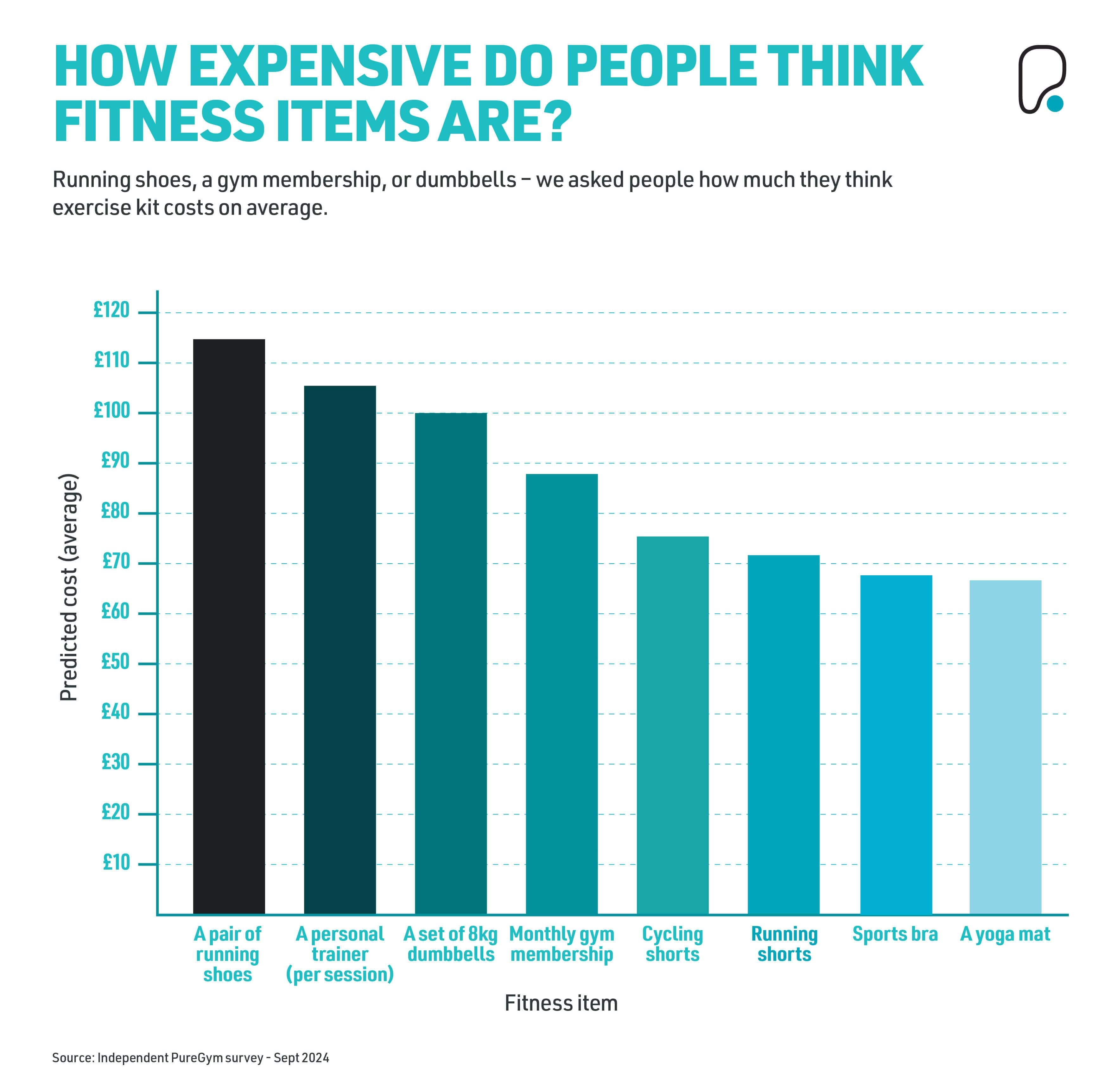
THE RISE OF FITNESS EVENTS
Key Findings:
Almost 1 in 5 (18%) people say they have entered, or are strongly intending to enter, a fitness related event within the next year
Fitness events are particularly popular among younger age groups, with 40% of 18-to-24-year-olds and 39% of 25-to-34-year-olds having entered, or planning to enter a fitness event in the next 12 months
Running events are the most popular type of fitness event to enter, with 23% of those that have entered an event or are planning to, aiming for a 5km run
The trend for Hyrox is clearly not slowing down, with 1 in 10 planning to take part in the functional fitness event
A quarter (24%) sign up for fitness events to give themselves a new challenge
15% of people that have entered, or are thinking about entering a fitness related event, have been inspired to do so by the 2024 Paris Olympics/Paralympics
As we all know, making fitness a long-term habit relies on finding a form of exercise you enjoy, building a solid routine, and then having the discipline to keep showing up. As a result, having a why behind our training can be a really effective way to help stay consistent by giving us something to aim for.
For almost 1 in 5 people, this takes the form of entering fitness events, such as a 5km run, Hyrox, or sports team competition, with 18% of people saying that they have entered, or intend to enter, one in the next 12 months. This is a trend that seems to be growing with time too, as younger age groups in particular are driven to enter fitness-themed events - 40% of people aged 18-to-24 say they have entered, or intend to enter, followed by 39% of those aged 25-to-34-years-old.
PT Zach Kingsbury from PureGym London explains why events can be so helpful for motivation: "Signing up for an event is one of the best ways to help you work towards a goal. Not only is there a big finale for you to take part in and enjoy at the end of your hard training, but the fact that you have a deadline that you yourself cannot change makes accountability so much easier to achieve. If you know you have to be ready by a certain date, procrastination and the "oh I'll do it another day" mentality become much less tempting. In many cases, events can also make certain disciplines much more enjoyable for people who are new to them. For example, the high energy and shared goal of people at a marathon makes completing the distance much more enjoyable. "
With that said, when it comes to the fitness events that are the most popular, running-based events take the top spot, with 23% of people intending to take part in an event, or already entered in one, eyeing up a 5km run, while 19% plan to participate in a half marathon. Given that running doesn't have a particularly high barrier of entry, events such as a 5km run are activity that many can take part in and is a great place to start for those who are new to fitness. Events such as Parkrun also provide a very welcoming and supportive atmosphere in which to complete a 5km, in turn creating a sense of community, which may help to incentivise people to take part.
Running-based events also seem to be more popular among women than men, with higher percentages of women intending to take part across all distances when compared to their male counterparts: 18% versus 15% for marathons, 20% versus 16% for 10km runs and 26% versus 20% for 5km runs.
The Most Popular Fitness Events In 2025
5km run - 23%
Half marathon - 19%
Sports team competition (eg. Sunday league football) - 19%
10km run - 18%
Cycling event (eg. RideLondon) - 17%
Marathon - 16%
Athletics event - 14%
Tough Mudder - 11%
Hyrox - 10%
Ultramarathon - 9%
Although events can motivate us to keep up with, or start a fitness routine, we also need a bit of motivation to sign up for one in the first place. For a quarter of people (24%) that have entered an event, wanting a new challenge was what gave them the push to sign up for an event. Family and friends are also a big source of motivation, with 20% saying that a friend or family member inspired them to enter, with another 20% spurred on to do so by their partner.
We also mentioned earlier that the Paris Olympics and Paralympics had resulted in people being inspired to exercise, and this inspiration seems to have continued right through to signing up to an event too. 15% of those that have signed up, have done so as a result of the 2024 Games!
The Main Things That Inspire People To Enter A Fitness Event
I want a new challenge - 24%
I want something to keep me motivated - 23%
A friend/family member - 20%
My partner - 20%
I previously enjoyed events I've taken part in - 18%
Seeing the event on social media - 17%
To tick it off my bucket list - 16%
The 2024 Olympics/Paralympics - 15%
Seeing the event on TV - 13%
Seeing the event in the news - 12%
If you're one of those that are planning on entering an event during 2025, or have already entered one, Zach's got some useful advice for you:
Know the event - the route, the timings, the history. Knowing the event inside out before you get there can make it much easier to plan for.
Have a structured training plan and stick to it!
Hire a coach if you need support - not only can they help you with your training plan, but they'll also provide advice, analysis and motivation for you, which is perfect if you're new to training for fitness-focused events.
Don't underestimate the discipline - whatever the discipline is and your history with it, treat it like you've never done it before. Hold yourself accountable, be determined and don't let anything get in the way of success.
Finally, look forward to the event, don't dread it. You can feed off energy from others throughout the day, so try and let the event getting closer in the calendar motivate you, rather than scare you.
FITNESS AND TECHNOLOGY
Key Findings:
Two thirds of people (66%) have used a smart device to monitor their personal health data, with 42% saying they do this either daily, or most of the time
1 in 5 (19%) say they feel guilty if they don't meet a goal set on their device, with 12% saying they feel anxious about the data the devices provide
37% of women say they track their menstrual cycle, with more than two thirds (68%) of those who use apps to do so, syncing their workout routines with their cycle
Compared to previous research by PureGym, the number of women syncing their workouts with their menstrual cycle has increased by 14% since 2022
50% of the population use YouTube for fitness advice and inspiration
77% of 18-to-24-year-olds use TikTok for fitness advice and inspiration, a 6% increase on last year
In our modern, tech-driven world, it can feel like there's a device for every need and purpose, and that's probably not too far from the truth. With smartphones, smart watches, smart rings, fitness trackers and countless other health monitors available to buy, there has never been more ways to keep tabs on our health, with detailed data on everything from sleep to steps all at our fingertips.
How do people use smart devices, and how do they feel about them?
According to our research, two thirds (66%) of people have used a smart device to monitor their personal health data, with 42% saying they monitor this data on a daily, or very regular basis. In many cases, this could be as simple as checking your step count on your phone or watch, but this can also extend much further to reveal our heart rate, how many hours of sleep we get, and other metrics like exertion and recovery.
Having access to such extensive data can be motivational, with metrics like step counts encouraging us to move more. This is the case for 24% of people who say they're more driven to by healthy or reach their goals when monitoring such data. A further 31% of people say that tracking these metrics makes them more aware of their health and fitness, while almost a fifth (19%) credit their access to this data with helping to improve their general fitness.
However, there is also another side to how this fitness-focused technology is impacting us; 19% say they feel guilty if they haven't met a goal they've set on their device, while 12% say the data they're given makes them anxious. Interestingly, women are most likely to feel guilty about not meeting goals set on their smart devices compared to men (22% versus 17%) but are also more likely to use the devices regularly (47% versus 37%).
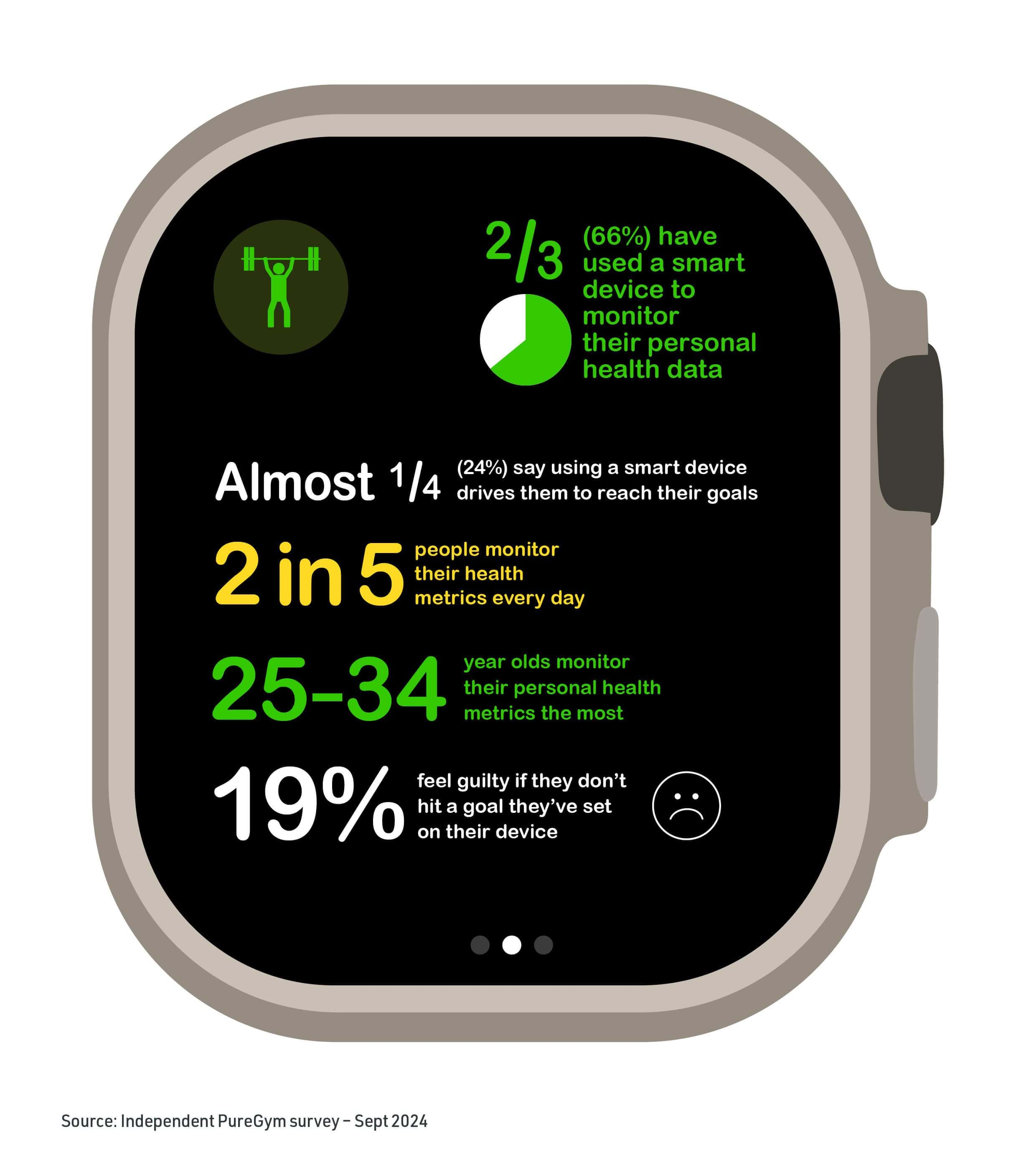
Tracking Menstrual Cycles and Cycle Syncing
When it comes to women and smart devices specifically, the ability to track menstrual cycles and view additional data surrounding this is a clear advantage provided by wearing health trackers. We ran research on the topic of menstrual health back in 2022 and found that 47% of women track their menstrual cycle, however this seems to have dropped by around 10% over the last two years, with just over a third (37%) now saying that they currently do so. Of those who do track their cycle using apps, 68% also sync their workout routines to match - an increase of 14% from 2022, when 54% of women did. This is also much more likely to be the case among younger women, with 25-to-34-year-olds most likely to cycle sync (73%), followed by 18-to-24-year-olds (70%).
The benefits of cycle syncing are also shown by our research, with 31% of women saying their mood has improved, 29% saying it helps them to manage their menstrual symptoms, and a quarter (25%) saying it has helped them improve their performance.
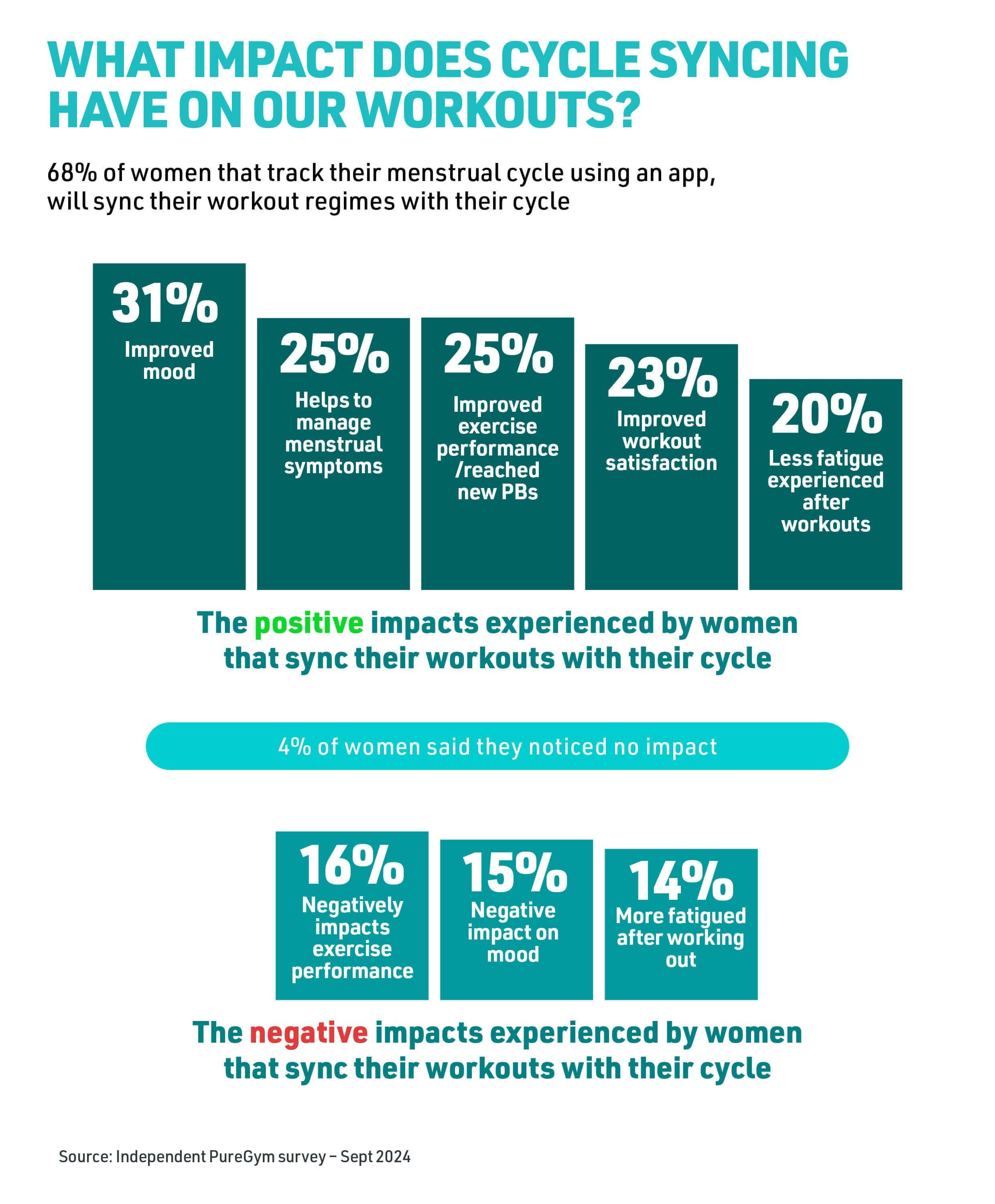
How does online media influence our fitness habits?
Outside of smart devices and tracking our metrics, technology has also given us many more opportunities to learn about fitness, seek out new ways to work out and find new sources of inspiration. Social media platforms such as Instagram and TikTok are filled with 'gymfluencers' sharing their favourite kit and workouts, while #runtok has also boomed in popularity, inspiring many more people to lace up their running shoes and hit the pavement.
But where are we really getting most of our fitness advice from? Keeping on trend from last year's report, YouTube is once again the most popular platform for fitness advice, with half of the population (50%) using the video-based site as their go-to. Surprisingly, 42% said that they use television programmes for inspiration, which seems to go somewhat against the grain in our world of short-form content. However, smartphone apps (40%) follow in third, with Facebook (38%) in fourth and Instagram in fifth (38%) - all very much staying on par with the results seen last year. Though TikTok may rank down in seventh overall (35%), it's clearly incredibly popular with younger generations, with more than three quarters (77%) of those aged 18-to-24 having used it for fitness advice, a 6% increase on last year.
According to PT Leah Bygraves-Paul from PureGym Sheffield, social media is a great tool when it comes to fitness, but one that should be used carefully: "Social media is great for helping people learn how to perform exercises safely, particularly if they don't have access to a gym, or are too shy to ask for help. However, the key thing to remember is that we should always interrogate our sources a bit - is a video scientifically backed, or is it just a copy and paste video of a trend that's come from an influencer who's always been fit? Similarly, is someone saying something purely for 'clout' or to sell something?"
"Before following any advice, you should ensure the content you're following is correct, so checking that someone is a qualified personal trainer, or that they're using good studies to support what they're saying. Don't be worried about asking them questions or doing your own research to check their statements!"
Much of the content shared on platforms like Instagram and TikTok comes from the phones of fitness influencers. Unfortunately, 14% of people say they compare themselves to these figures, with this number rising to 26% for those who exercise. The comparison game is most likely to be played by those aged 18-to-24 too, with more than a third (36%) saying that they compare themselves to fitness influencers - more than any other age group.
It's important to remember that all bodies and abilities are different, and while having a role model is fine, comparing how you look and train with people online can be harmful. Fitness influencers may not be truthful about their diet and exercise routines, and are often paid to look and be in shape so can dedicate more time to it. This means it's not always realistic to compare yourself to people online.
LOOKING AHEAD: FITNESS TRENDS FOR 2025
Key Findings:
- 'Remote personal training' is set to be the biggest fitness trend in 2025, with a whopping 414% increase in interest as we reach the end of the year
- Hyrox, which ranked in fourth place in 2023/24, jumps up to second position, again seeing a 233% increase in interest
- The viral 30-30-30 trend makes its way into the top three for 2025, with a 175% increase in interest
- Though their popularity remains, the interest in Pilates based workouts seems to be slowing, with tower Pilates, reformer Pilates and mat Pilates all falling in the top 30 this year
- Meanwhile, the declining workouts prove that trends really do come and go, with soft hiking (-56%), 12-3-30 (-55%) and the treadmill strut (-56%) all among those which have seen the biggest drops in interest
To finish things up we always like to look into the trends that are set to take the next year by storm, and this year is no different. Last year we revealed Wall Pilates as our top trend for 2024, and based on the amount of Pilates content we've seen on our social media feeds over the past twelve months, it seems that this was quite an accurate prediction!
So, let's not leave it any longer; here are our top picks of the workouts and trends that you can expect to see much more of in 2025.
The Top Fitness Trends for 2025
As we saw last year, our analysis always highlights that trends are fleeting and may not be around for very long. In 2023, weighted hula hoops and stroller fitness were among the top-ranking trends, only to see a huge drop for 2024, and this year is no different. Though they may have had viral popularity at their peak, TikTok trends such as the treadmill strut, soft hiking, and 12-3-30 all fall among the trends that have seen the biggest decrease in popularity over the past 12 months. The treadmill strut and 12-3-30 in particular ranked among our top five trending workouts in 2023, while wall Pilates, which saw a 55% drop in interest this year, was our top workout for 2024.
Taking the top spot for 2025, with a huge 414% increase in popularity, is 'remote personal training'. Less of a viral fitness fad like the treadmill strut or 12-3-30 workouts, this instead signals a change in how many people are working with personal trainers to reach their fitness goals.
Just as the COVID-19 pandemic has now resulted in remote working becoming a fixture in modern life, personal training is also benefitting from the wonders of technology, with an increased number of trainers offering online services. This enables custom programs to be created from anywhere in the world, allowing people to work with a wider variety of trainers, or simply negotiate tricky schedules. For many people, it's accountability that is the main driver to sticking with a plan, and remote sessions can definitely tick this box.
Hyrox (233%) moves up to become the second biggest fitness trend for 2025, with the functional fitness race event continuing to rise in popularity, building on the fourth position it secured in last year's rankings - begging the question, will it reach the top spot by the end of 2025? As we've already discussed, 1 in 10 Brits currently intend to take part in a Hyrox event over the next twelve months, so there's something about the intense workout, race style and community that's clearly proving to be a recipe for success for the brand.
We also noted earlier in the report that weight loss is a fitness goal for 1 in 3 people, which has likely played a big part in the 30-30-30 rule's rise in popularity. Standing for eating 30 grams of protein, within 30 minutes of waking up, followed by 30-minutes of low-intensity exercise, this ranks as the third top trend for 2025. The viral 'rule' originates from the book 'The Four Hour Body' which was released all the way back in 2010, but has risen to prominence once again after TikTok creator and biologist Gary Brecka described it in one of his videos.
Following on from the Tarzan movement and primal movement trends that entered the rankings last year, quadrobics (174%) places in the top 10 for 2025. A full body workout that involves mimicking animal movement while on all fours, quadrobics targets the quadricep muscles with the aim of improving strength, agility and coordination. Though Tarzan movement may have seen a huge decrease this year, there's clearly still appetite for these types of movements, with functional fitness (124%) also making it into the top 10.
Breaking classes also made it into the top 15, likely as a result of breaking featuring as an Olympic sport for the first time this summer, and the virality of Australian competitor Raygun.
2025 Trends, ranked by % increase in Google searches from July - Sept 23 vs July - Sept 24
Remote personal training - 414%
Hyrox - 233%
30-30-30 - 175%
Quadrobics - 174%
Virtual fitness - 173%
Stroller fitness - 127%
Step aerobics - 124%
Functional fitness - 124%
Rollerblading - 123%
Hiking - 122%
Rainbow walk - 116%
Physical esports - 100%
Breaking classes - 86%
Adaptive fitness - 85%
Boxing - 84%
Functional fitness training - 83%
Incline walk - 83%
Primal fitness - 83%
Tower pilates - 83%
Rucking - 83%
Which fitness trends are on their way out?
As the saying goes, what goes up, must come down, and this is definitely the case when it comes to a lot of fitness trends. Generally, it's the more niche, or 'flash in the pan' viral trends that seem to be the biggest losers after their day in the spotlight.
As we've mentioned already, Tarzan movement and 12-3-30 were big trends in previous years, and topped our 2023 and 2024 predictions lists, but are hanging out at the lower end of the charts for 2025. Branded workouts seem to be among those that see the biggest increases and decreases too, with Zuu fitness featuring in the bottom flight for the second year running, accompanied by pvolve, the workout that's a favourite of Jennifer Aniston, but also ranked very highly in 2024.
Surprisingly, the wall Pilates trend has also been one of the big losers for 2025, after being crowned the top trending workout for 2024 at the start of the year. Several Pilates-based workouts have remained in the top 10, so there's clearly still appetite for the form of fitness as a whole - it seems to be that other popular forms of Pilates such as reformer and mat are just continuing to reign supreme.
28-day wall pilates challenge: -84%
Treadmill strut: -56%
Soft hiking: -56%
Tarzan movement: -56%
12-3-30: -55%
Wall pilates: -55%
Stepper-ton: -47%
Aqua spin: -47%
Outdoor personal trainer: -47%
Beer yoga: -46%
Pvolve: -45%
Barefoot cardio: -40%
Pillow workouts: -34%
Workout challenges: -33%
Jaw workout: -33%
Bokwa: -33%
Naked yoga: -33%
HIIT: -33%
Neck workout: -33%
Face yoga: -33%
Ready to reach your health and fitness aspirations?
That's a wrap on this version of the UK Fitness Report! Another year where fitness trends will come and go, but importantly, one we hope will continue to see the nation's focus on good health keep rising. As you will have read throughout this report, we can see that more people are exercising or at the very least, planning on making a start within the next twelve months.
So let's make 2025 the year it happens. It all starts with more movement, and if you feel the gym could be the place to help you to reach your personal health and fitness aspirations, take a look at our gym membership options now.
Methodology
Data was compiled for the report using the following sources:
- YouGov survey (representative of respondents in Great Britain) - compiled using data from 22/09/2024
- PureGym internal customer data
- Google Keyword Planner (fitness trends) analysing worldwide search volume. Correct as of October 2024
- Certain trends were omitted from the rankings if their search volumes were not representative of an increase in interest. (For example, 'puppy yoga' gained widespread attention for the mistreatment of animals, rather than interest from a consumer point of view, so was removed from the rankings).
- Censuswide survey - 2,006 nationally representative respondents, conducted in September 2024
Interested in covering the stats with this report?
If you're interested in covering a stat in the report, or wanted to know more about other data we may have, please contact [email protected] and a member of the team will get back in touch soon!
Sources cited within the report:
Biddle, S. J. H., et al. (2019). "Effects of Exercise on Mental Health." International Journal of Behavioral Nutrition and Physical Activity.
Carron, A. V., et al. (2020). "Social Cohesion in Team Sports: A Review." Journal of Sport & Exercise Psychology.
Sallis, J. F., et al. (2021). "Social Support and Exercise: A Review." American Journal of Health Promotion.
